Apply Legal Principles in Corporation Law Matters
VerifiedAdded on 2023/06/18
|18
|6432
|172
AI Summary
This content covers legal principles in corporation law matters, including updates on changes in law, researching legislation, company structure, memorandum of association, duties of directors, ethical behavior, privacy rules, subsidiary companies, compliance, prospectus, and taking minutes at meetings. It also includes an assessment section with explanations of subscriber and shareholder, ordinary and special resolution, and theories of corporation law. Subject: Corporation Law, Course Code: CLAW1001, College/University: Not mentioned.
Contribute Materials
Your contribution can guide someone’s learning journey. Share your
documents today.
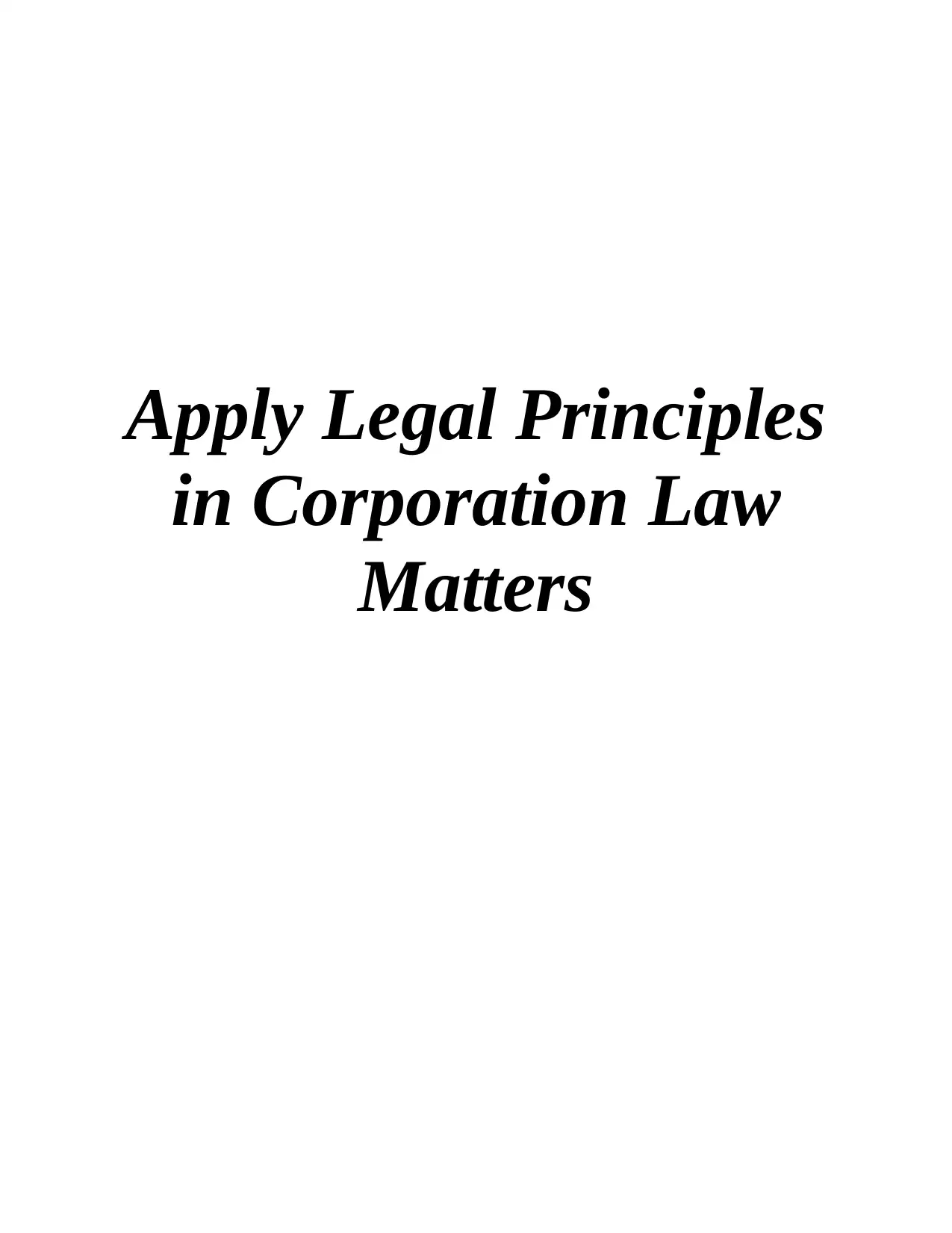
Apply Legal Principles
in Corporation Law
Matters
in Corporation Law
Matters
Secure Best Marks with AI Grader
Need help grading? Try our AI Grader for instant feedback on your assignments.
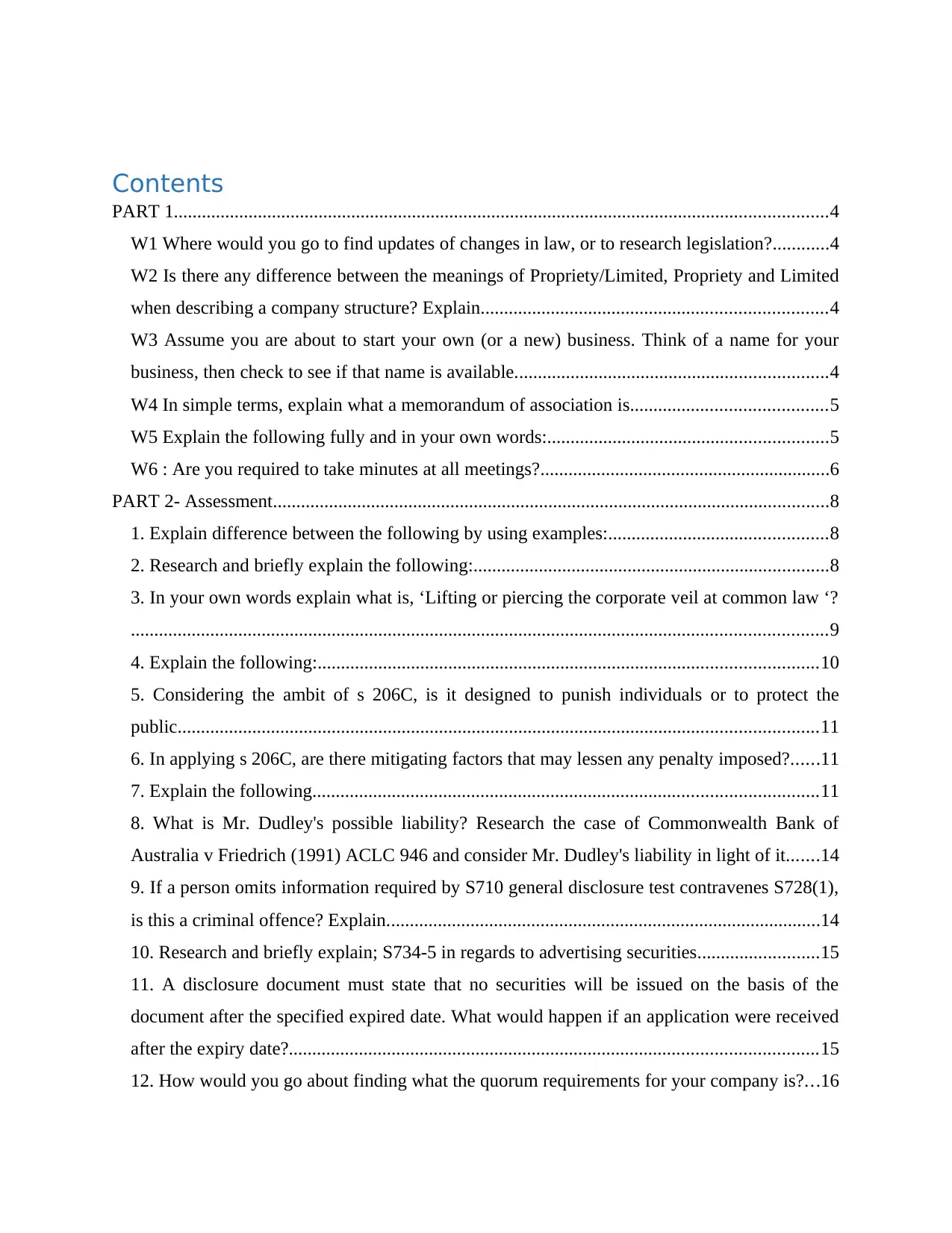
Contents
PART 1............................................................................................................................................4
W1 Where would you go to find updates of changes in law, or to research legislation?............4
W2 Is there any difference between the meanings of Propriety/Limited, Propriety and Limited
when describing a company structure? Explain..........................................................................4
W3 Assume you are about to start your own (or a new) business. Think of a name for your
business, then check to see if that name is available...................................................................4
W4 In simple terms, explain what a memorandum of association is..........................................5
W5 Explain the following fully and in your own words:............................................................5
W6 : Are you required to take minutes at all meetings?..............................................................6
PART 2- Assessment.......................................................................................................................8
1. Explain difference between the following by using examples:...............................................8
2. Research and briefly explain the following:............................................................................8
3. In your own words explain what is, ‘Lifting or piercing the corporate veil at common law ‘?
.....................................................................................................................................................9
4. Explain the following:...........................................................................................................10
5. Considering the ambit of s 206C, is it designed to punish individuals or to protect the
public.........................................................................................................................................11
6. In applying s 206C, are there mitigating factors that may lessen any penalty imposed?......11
7. Explain the following............................................................................................................11
8. What is Mr. Dudley's possible liability? Research the case of Commonwealth Bank of
Australia v Friedrich (1991) ACLC 946 and consider Mr. Dudley's liability in light of it.......14
9. If a person omits information required by S710 general disclosure test contravenes S728(1),
is this a criminal offence? Explain.............................................................................................14
10. Research and briefly explain; S734-5 in regards to advertising securities..........................15
11. A disclosure document must state that no securities will be issued on the basis of the
document after the specified expired date. What would happen if an application were received
after the expiry date?.................................................................................................................15
12. How would you go about finding what the quorum requirements for your company is?...16
PART 1............................................................................................................................................4
W1 Where would you go to find updates of changes in law, or to research legislation?............4
W2 Is there any difference between the meanings of Propriety/Limited, Propriety and Limited
when describing a company structure? Explain..........................................................................4
W3 Assume you are about to start your own (or a new) business. Think of a name for your
business, then check to see if that name is available...................................................................4
W4 In simple terms, explain what a memorandum of association is..........................................5
W5 Explain the following fully and in your own words:............................................................5
W6 : Are you required to take minutes at all meetings?..............................................................6
PART 2- Assessment.......................................................................................................................8
1. Explain difference between the following by using examples:...............................................8
2. Research and briefly explain the following:............................................................................8
3. In your own words explain what is, ‘Lifting or piercing the corporate veil at common law ‘?
.....................................................................................................................................................9
4. Explain the following:...........................................................................................................10
5. Considering the ambit of s 206C, is it designed to punish individuals or to protect the
public.........................................................................................................................................11
6. In applying s 206C, are there mitigating factors that may lessen any penalty imposed?......11
7. Explain the following............................................................................................................11
8. What is Mr. Dudley's possible liability? Research the case of Commonwealth Bank of
Australia v Friedrich (1991) ACLC 946 and consider Mr. Dudley's liability in light of it.......14
9. If a person omits information required by S710 general disclosure test contravenes S728(1),
is this a criminal offence? Explain.............................................................................................14
10. Research and briefly explain; S734-5 in regards to advertising securities..........................15
11. A disclosure document must state that no securities will be issued on the basis of the
document after the specified expired date. What would happen if an application were received
after the expiry date?.................................................................................................................15
12. How would you go about finding what the quorum requirements for your company is?...16
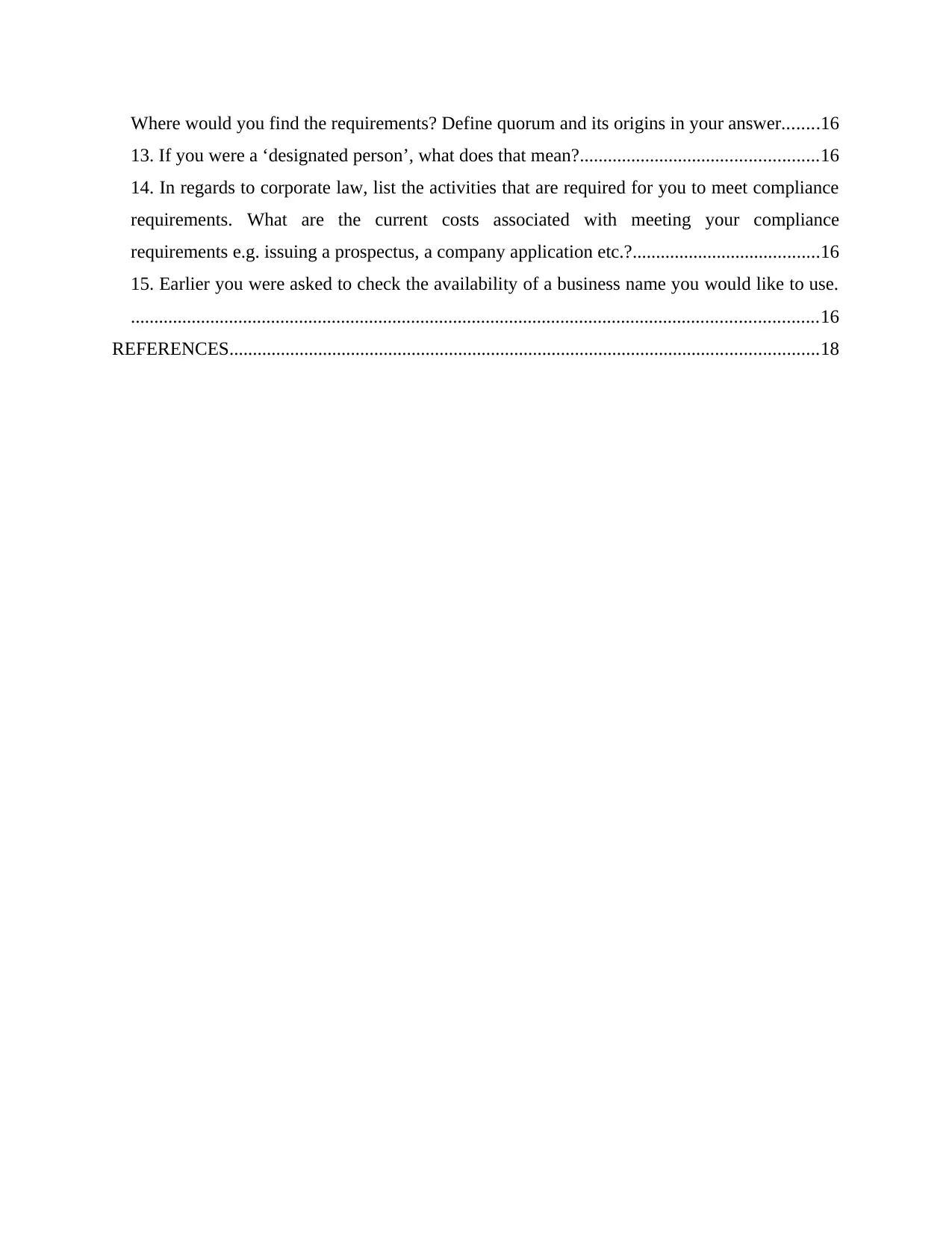
Where would you find the requirements? Define quorum and its origins in your answer........16
13. If you were a ‘designated person’, what does that mean?...................................................16
14. In regards to corporate law, list the activities that are required for you to meet compliance
requirements. What are the current costs associated with meeting your compliance
requirements e.g. issuing a prospectus, a company application etc.?........................................16
15. Earlier you were asked to check the availability of a business name you would like to use.
...................................................................................................................................................16
REFERENCES..............................................................................................................................18
13. If you were a ‘designated person’, what does that mean?...................................................16
14. In regards to corporate law, list the activities that are required for you to meet compliance
requirements. What are the current costs associated with meeting your compliance
requirements e.g. issuing a prospectus, a company application etc.?........................................16
15. Earlier you were asked to check the availability of a business name you would like to use.
...................................................................................................................................................16
REFERENCES..............................................................................................................................18
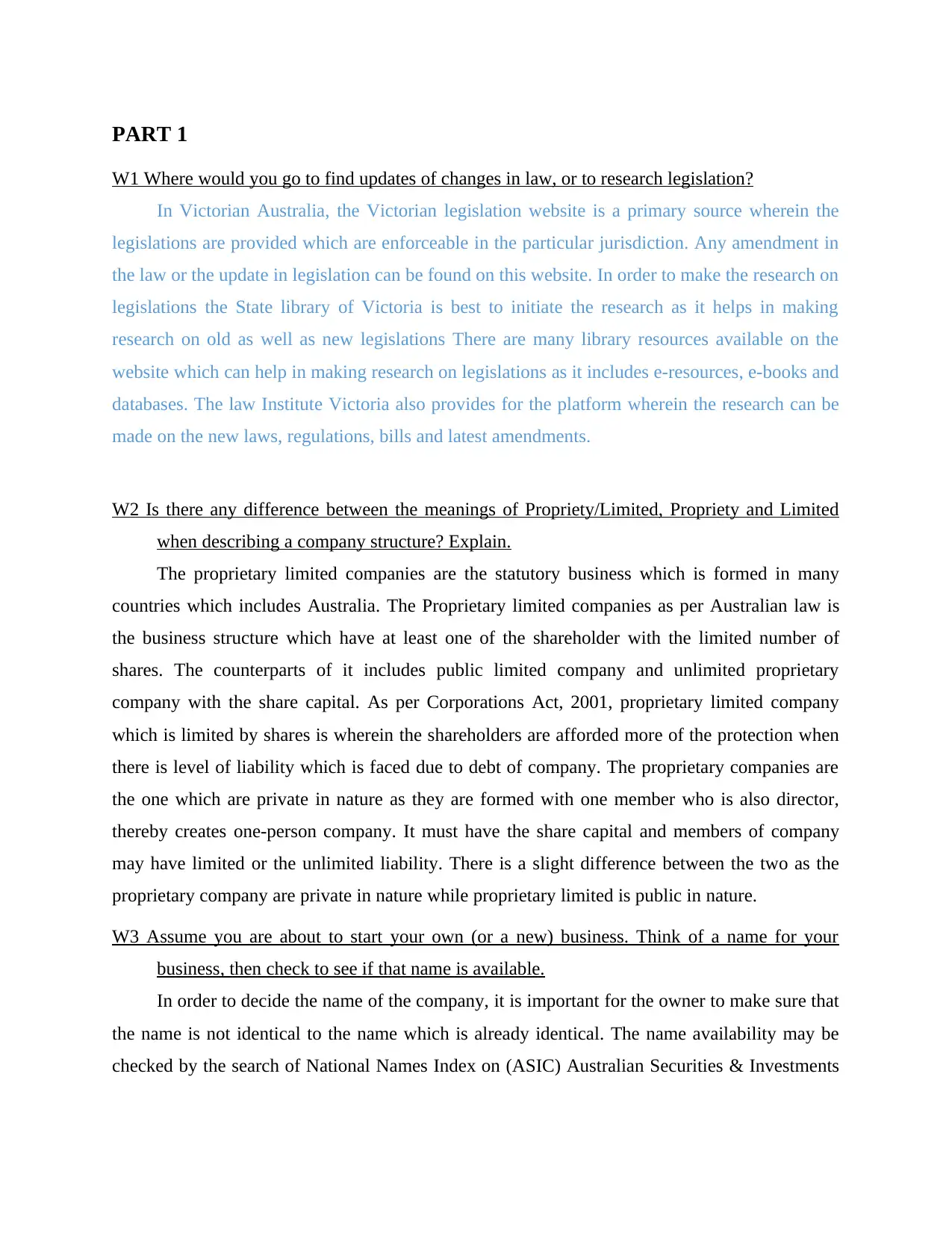
PART 1
W1 Where would you go to find updates of changes in law, or to research legislation?
In Victorian Australia, the Victorian legislation website is a primary source wherein the
legislations are provided which are enforceable in the particular jurisdiction. Any amendment in
the law or the update in legislation can be found on this website. In order to make the research on
legislations the State library of Victoria is best to initiate the research as it helps in making
research on old as well as new legislations There are many library resources available on the
website which can help in making research on legislations as it includes e-resources, e-books and
databases. The law Institute Victoria also provides for the platform wherein the research can be
made on the new laws, regulations, bills and latest amendments.
W2 Is there any difference between the meanings of Propriety/Limited, Propriety and Limited
when describing a company structure? Explain.
The proprietary limited companies are the statutory business which is formed in many
countries which includes Australia. The Proprietary limited companies as per Australian law is
the business structure which have at least one of the shareholder with the limited number of
shares. The counterparts of it includes public limited company and unlimited proprietary
company with the share capital. As per Corporations Act, 2001, proprietary limited company
which is limited by shares is wherein the shareholders are afforded more of the protection when
there is level of liability which is faced due to debt of company. The proprietary companies are
the one which are private in nature as they are formed with one member who is also director,
thereby creates one-person company. It must have the share capital and members of company
may have limited or the unlimited liability. There is a slight difference between the two as the
proprietary company are private in nature while proprietary limited is public in nature.
W3 Assume you are about to start your own (or a new) business. Think of a name for your
business, then check to see if that name is available.
In order to decide the name of the company, it is important for the owner to make sure that
the name is not identical to the name which is already identical. The name availability may be
checked by the search of National Names Index on (ASIC) Australian Securities & Investments
W1 Where would you go to find updates of changes in law, or to research legislation?
In Victorian Australia, the Victorian legislation website is a primary source wherein the
legislations are provided which are enforceable in the particular jurisdiction. Any amendment in
the law or the update in legislation can be found on this website. In order to make the research on
legislations the State library of Victoria is best to initiate the research as it helps in making
research on old as well as new legislations There are many library resources available on the
website which can help in making research on legislations as it includes e-resources, e-books and
databases. The law Institute Victoria also provides for the platform wherein the research can be
made on the new laws, regulations, bills and latest amendments.
W2 Is there any difference between the meanings of Propriety/Limited, Propriety and Limited
when describing a company structure? Explain.
The proprietary limited companies are the statutory business which is formed in many
countries which includes Australia. The Proprietary limited companies as per Australian law is
the business structure which have at least one of the shareholder with the limited number of
shares. The counterparts of it includes public limited company and unlimited proprietary
company with the share capital. As per Corporations Act, 2001, proprietary limited company
which is limited by shares is wherein the shareholders are afforded more of the protection when
there is level of liability which is faced due to debt of company. The proprietary companies are
the one which are private in nature as they are formed with one member who is also director,
thereby creates one-person company. It must have the share capital and members of company
may have limited or the unlimited liability. There is a slight difference between the two as the
proprietary company are private in nature while proprietary limited is public in nature.
W3 Assume you are about to start your own (or a new) business. Think of a name for your
business, then check to see if that name is available.
In order to decide the name of the company, it is important for the owner to make sure that
the name is not identical to the name which is already identical. The name availability may be
checked by the search of National Names Index on (ASIC) Australian Securities & Investments
Secure Best Marks with AI Grader
Need help grading? Try our AI Grader for instant feedback on your assignments.
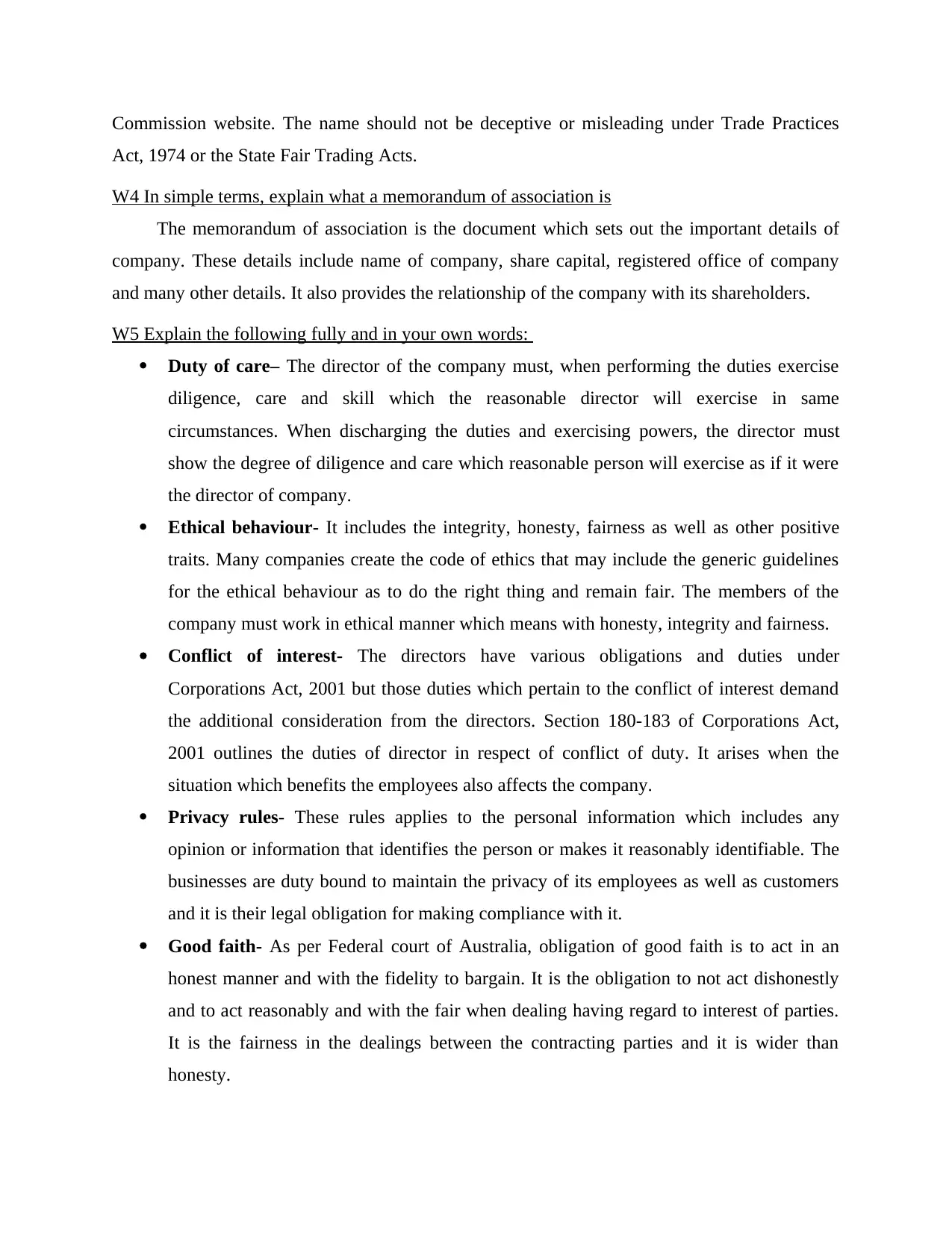
Commission website. The name should not be deceptive or misleading under Trade Practices
Act, 1974 or the State Fair Trading Acts.
W4 In simple terms, explain what a memorandum of association is
The memorandum of association is the document which sets out the important details of
company. These details include name of company, share capital, registered office of company
and many other details. It also provides the relationship of the company with its shareholders.
W5 Explain the following fully and in your own words:
Duty of care– The director of the company must, when performing the duties exercise
diligence, care and skill which the reasonable director will exercise in same
circumstances. When discharging the duties and exercising powers, the director must
show the degree of diligence and care which reasonable person will exercise as if it were
the director of company.
Ethical behaviour- It includes the integrity, honesty, fairness as well as other positive
traits. Many companies create the code of ethics that may include the generic guidelines
for the ethical behaviour as to do the right thing and remain fair. The members of the
company must work in ethical manner which means with honesty, integrity and fairness.
Conflict of interest- The directors have various obligations and duties under
Corporations Act, 2001 but those duties which pertain to the conflict of interest demand
the additional consideration from the directors. Section 180-183 of Corporations Act,
2001 outlines the duties of director in respect of conflict of duty. It arises when the
situation which benefits the employees also affects the company.
Privacy rules- These rules applies to the personal information which includes any
opinion or information that identifies the person or makes it reasonably identifiable. The
businesses are duty bound to maintain the privacy of its employees as well as customers
and it is their legal obligation for making compliance with it.
Good faith- As per Federal court of Australia, obligation of good faith is to act in an
honest manner and with the fidelity to bargain. It is the obligation to not act dishonestly
and to act reasonably and with the fair when dealing having regard to interest of parties.
It is the fairness in the dealings between the contracting parties and it is wider than
honesty.
Act, 1974 or the State Fair Trading Acts.
W4 In simple terms, explain what a memorandum of association is
The memorandum of association is the document which sets out the important details of
company. These details include name of company, share capital, registered office of company
and many other details. It also provides the relationship of the company with its shareholders.
W5 Explain the following fully and in your own words:
Duty of care– The director of the company must, when performing the duties exercise
diligence, care and skill which the reasonable director will exercise in same
circumstances. When discharging the duties and exercising powers, the director must
show the degree of diligence and care which reasonable person will exercise as if it were
the director of company.
Ethical behaviour- It includes the integrity, honesty, fairness as well as other positive
traits. Many companies create the code of ethics that may include the generic guidelines
for the ethical behaviour as to do the right thing and remain fair. The members of the
company must work in ethical manner which means with honesty, integrity and fairness.
Conflict of interest- The directors have various obligations and duties under
Corporations Act, 2001 but those duties which pertain to the conflict of interest demand
the additional consideration from the directors. Section 180-183 of Corporations Act,
2001 outlines the duties of director in respect of conflict of duty. It arises when the
situation which benefits the employees also affects the company.
Privacy rules- These rules applies to the personal information which includes any
opinion or information that identifies the person or makes it reasonably identifiable. The
businesses are duty bound to maintain the privacy of its employees as well as customers
and it is their legal obligation for making compliance with it.
Good faith- As per Federal court of Australia, obligation of good faith is to act in an
honest manner and with the fidelity to bargain. It is the obligation to not act dishonestly
and to act reasonably and with the fair when dealing having regard to interest of parties.
It is the fairness in the dealings between the contracting parties and it is wider than
honesty.
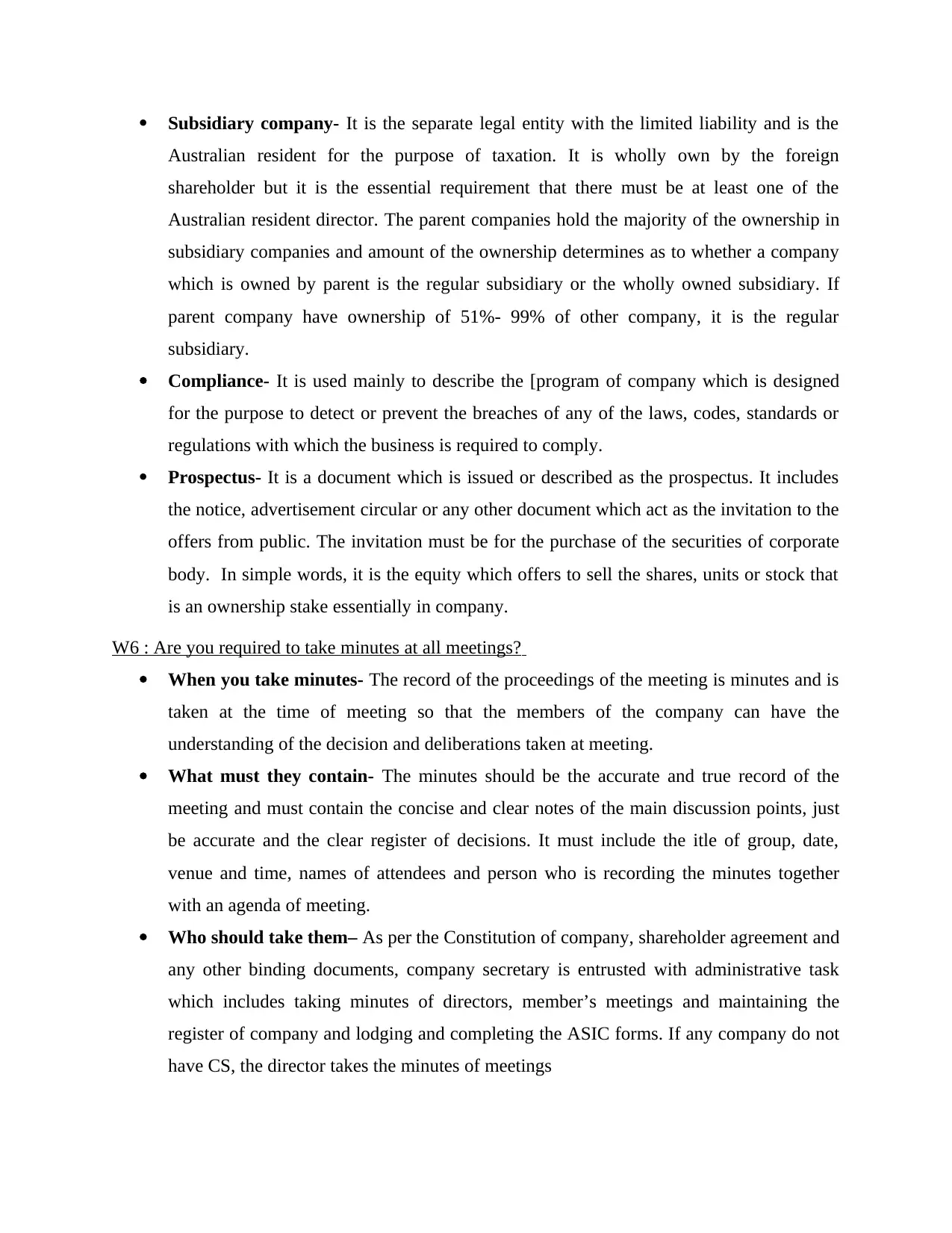
Subsidiary company- It is the separate legal entity with the limited liability and is the
Australian resident for the purpose of taxation. It is wholly own by the foreign
shareholder but it is the essential requirement that there must be at least one of the
Australian resident director. The parent companies hold the majority of the ownership in
subsidiary companies and amount of the ownership determines as to whether a company
which is owned by parent is the regular subsidiary or the wholly owned subsidiary. If
parent company have ownership of 51%- 99% of other company, it is the regular
subsidiary.
Compliance- It is used mainly to describe the [program of company which is designed
for the purpose to detect or prevent the breaches of any of the laws, codes, standards or
regulations with which the business is required to comply.
Prospectus- It is a document which is issued or described as the prospectus. It includes
the notice, advertisement circular or any other document which act as the invitation to the
offers from public. The invitation must be for the purchase of the securities of corporate
body. In simple words, it is the equity which offers to sell the shares, units or stock that
is an ownership stake essentially in company.
W6 : Are you required to take minutes at all meetings?
When you take minutes- The record of the proceedings of the meeting is minutes and is
taken at the time of meeting so that the members of the company can have the
understanding of the decision and deliberations taken at meeting.
What must they contain- The minutes should be the accurate and true record of the
meeting and must contain the concise and clear notes of the main discussion points, just
be accurate and the clear register of decisions. It must include the itle of group, date,
venue and time, names of attendees and person who is recording the minutes together
with an agenda of meeting.
Who should take them– As per the Constitution of company, shareholder agreement and
any other binding documents, company secretary is entrusted with administrative task
which includes taking minutes of directors, member’s meetings and maintaining the
register of company and lodging and completing the ASIC forms. If any company do not
have CS, the director takes the minutes of meetings
Australian resident for the purpose of taxation. It is wholly own by the foreign
shareholder but it is the essential requirement that there must be at least one of the
Australian resident director. The parent companies hold the majority of the ownership in
subsidiary companies and amount of the ownership determines as to whether a company
which is owned by parent is the regular subsidiary or the wholly owned subsidiary. If
parent company have ownership of 51%- 99% of other company, it is the regular
subsidiary.
Compliance- It is used mainly to describe the [program of company which is designed
for the purpose to detect or prevent the breaches of any of the laws, codes, standards or
regulations with which the business is required to comply.
Prospectus- It is a document which is issued or described as the prospectus. It includes
the notice, advertisement circular or any other document which act as the invitation to the
offers from public. The invitation must be for the purchase of the securities of corporate
body. In simple words, it is the equity which offers to sell the shares, units or stock that
is an ownership stake essentially in company.
W6 : Are you required to take minutes at all meetings?
When you take minutes- The record of the proceedings of the meeting is minutes and is
taken at the time of meeting so that the members of the company can have the
understanding of the decision and deliberations taken at meeting.
What must they contain- The minutes should be the accurate and true record of the
meeting and must contain the concise and clear notes of the main discussion points, just
be accurate and the clear register of decisions. It must include the itle of group, date,
venue and time, names of attendees and person who is recording the minutes together
with an agenda of meeting.
Who should take them– As per the Constitution of company, shareholder agreement and
any other binding documents, company secretary is entrusted with administrative task
which includes taking minutes of directors, member’s meetings and maintaining the
register of company and lodging and completing the ASIC forms. If any company do not
have CS, the director takes the minutes of meetings
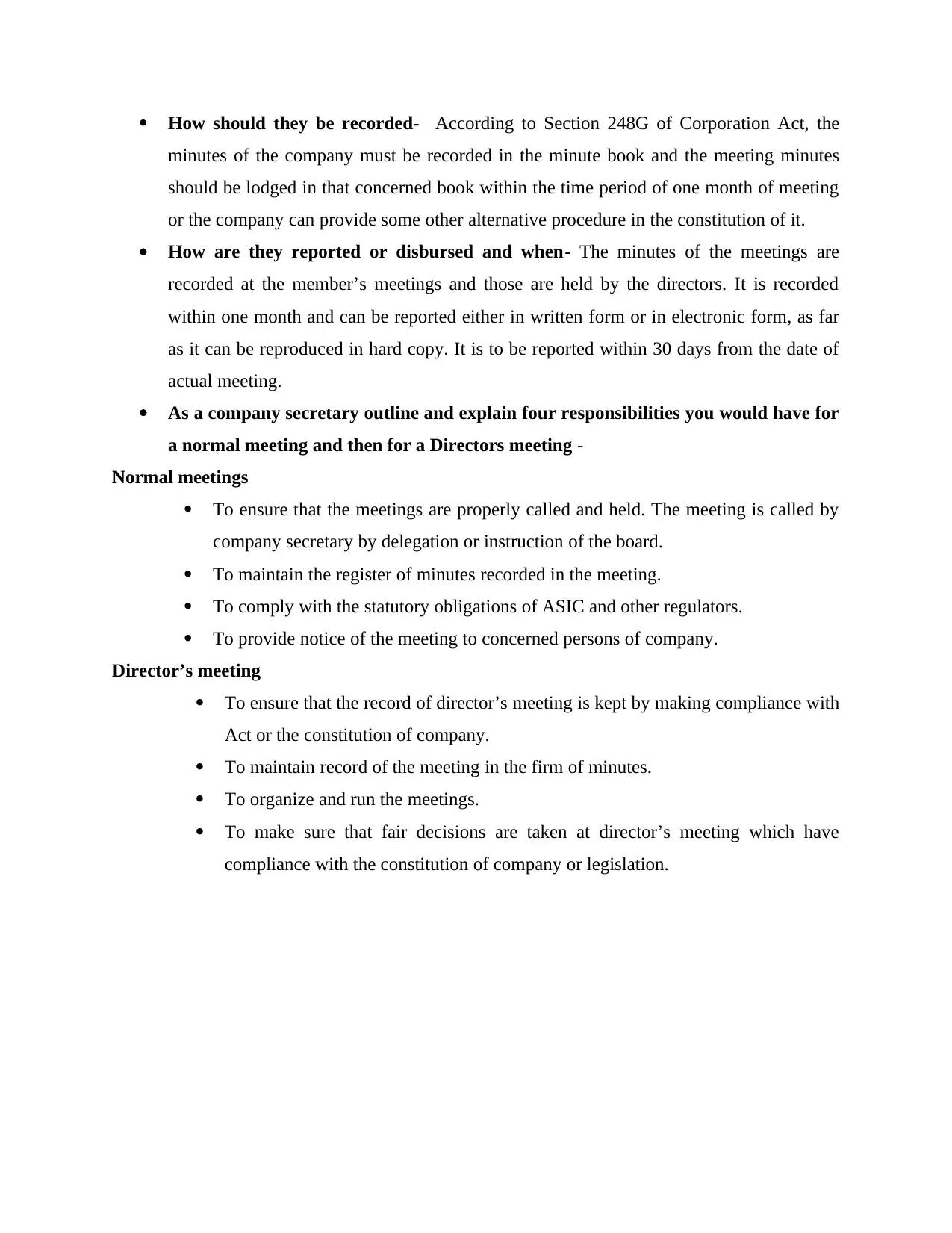
How should they be recorded- According to Section 248G of Corporation Act, the
minutes of the company must be recorded in the minute book and the meeting minutes
should be lodged in that concerned book within the time period of one month of meeting
or the company can provide some other alternative procedure in the constitution of it.
How are they reported or disbursed and when- The minutes of the meetings are
recorded at the member’s meetings and those are held by the directors. It is recorded
within one month and can be reported either in written form or in electronic form, as far
as it can be reproduced in hard copy. It is to be reported within 30 days from the date of
actual meeting.
As a company secretary outline and explain four responsibilities you would have for
a normal meeting and then for a Directors meeting -
Normal meetings
To ensure that the meetings are properly called and held. The meeting is called by
company secretary by delegation or instruction of the board.
To maintain the register of minutes recorded in the meeting.
To comply with the statutory obligations of ASIC and other regulators.
To provide notice of the meeting to concerned persons of company.
Director’s meeting
To ensure that the record of director’s meeting is kept by making compliance with
Act or the constitution of company.
To maintain record of the meeting in the firm of minutes.
To organize and run the meetings.
To make sure that fair decisions are taken at director’s meeting which have
compliance with the constitution of company or legislation.
minutes of the company must be recorded in the minute book and the meeting minutes
should be lodged in that concerned book within the time period of one month of meeting
or the company can provide some other alternative procedure in the constitution of it.
How are they reported or disbursed and when- The minutes of the meetings are
recorded at the member’s meetings and those are held by the directors. It is recorded
within one month and can be reported either in written form or in electronic form, as far
as it can be reproduced in hard copy. It is to be reported within 30 days from the date of
actual meeting.
As a company secretary outline and explain four responsibilities you would have for
a normal meeting and then for a Directors meeting -
Normal meetings
To ensure that the meetings are properly called and held. The meeting is called by
company secretary by delegation or instruction of the board.
To maintain the register of minutes recorded in the meeting.
To comply with the statutory obligations of ASIC and other regulators.
To provide notice of the meeting to concerned persons of company.
Director’s meeting
To ensure that the record of director’s meeting is kept by making compliance with
Act or the constitution of company.
To maintain record of the meeting in the firm of minutes.
To organize and run the meetings.
To make sure that fair decisions are taken at director’s meeting which have
compliance with the constitution of company or legislation.
Paraphrase This Document
Need a fresh take? Get an instant paraphrase of this document with our AI Paraphraser
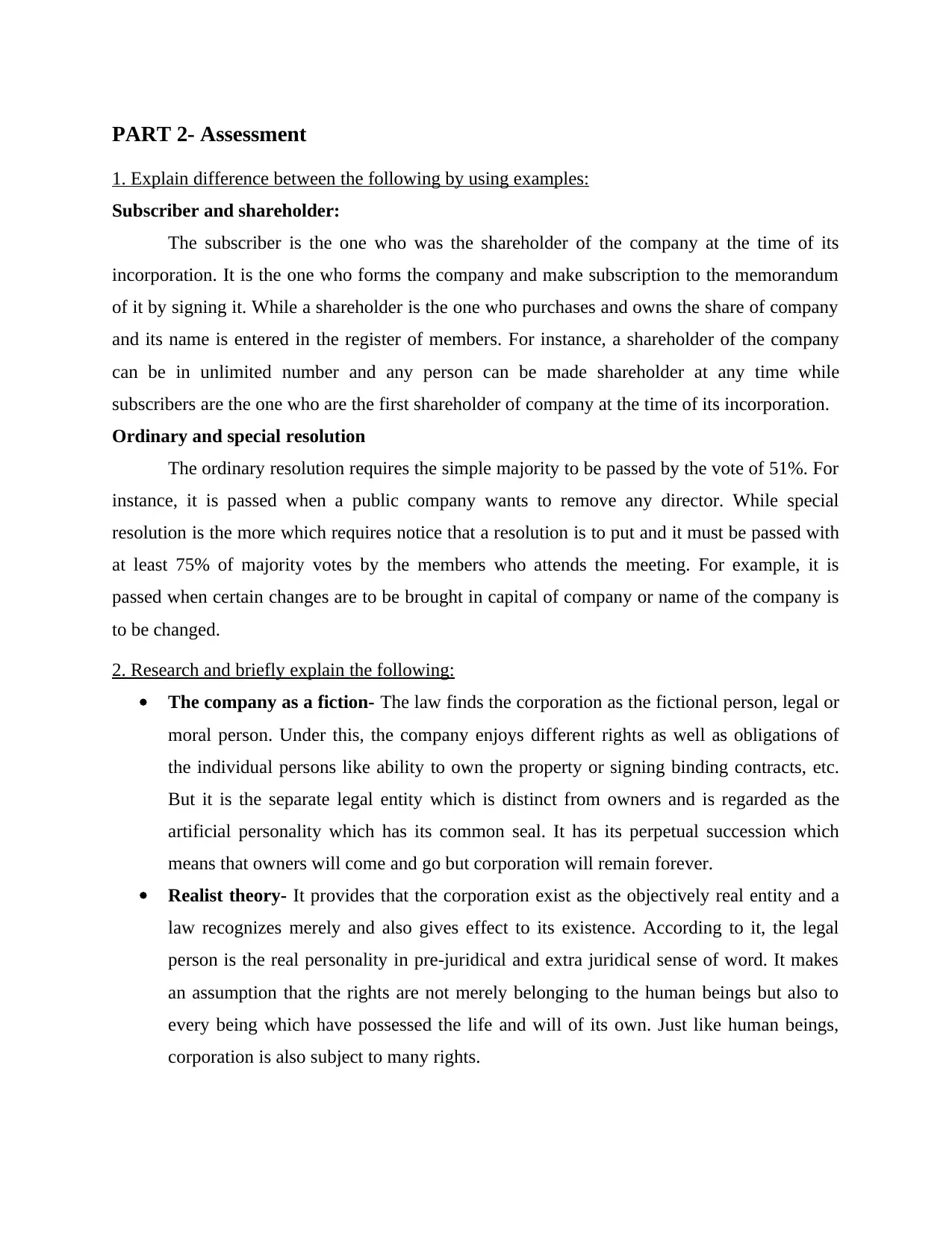
PART 2- Assessment
1. Explain difference between the following by using examples:
Subscriber and shareholder:
The subscriber is the one who was the shareholder of the company at the time of its
incorporation. It is the one who forms the company and make subscription to the memorandum
of it by signing it. While a shareholder is the one who purchases and owns the share of company
and its name is entered in the register of members. For instance, a shareholder of the company
can be in unlimited number and any person can be made shareholder at any time while
subscribers are the one who are the first shareholder of company at the time of its incorporation.
Ordinary and special resolution
The ordinary resolution requires the simple majority to be passed by the vote of 51%. For
instance, it is passed when a public company wants to remove any director. While special
resolution is the more which requires notice that a resolution is to put and it must be passed with
at least 75% of majority votes by the members who attends the meeting. For example, it is
passed when certain changes are to be brought in capital of company or name of the company is
to be changed.
2. Research and briefly explain the following:
The company as a fiction- The law finds the corporation as the fictional person, legal or
moral person. Under this, the company enjoys different rights as well as obligations of
the individual persons like ability to own the property or signing binding contracts, etc.
But it is the separate legal entity which is distinct from owners and is regarded as the
artificial personality which has its common seal. It has its perpetual succession which
means that owners will come and go but corporation will remain forever.
Realist theory- It provides that the corporation exist as the objectively real entity and a
law recognizes merely and also gives effect to its existence. According to it, the legal
person is the real personality in pre-juridical and extra juridical sense of word. It makes
an assumption that the rights are not merely belonging to the human beings but also to
every being which have possessed the life and will of its own. Just like human beings,
corporation is also subject to many rights.
1. Explain difference between the following by using examples:
Subscriber and shareholder:
The subscriber is the one who was the shareholder of the company at the time of its
incorporation. It is the one who forms the company and make subscription to the memorandum
of it by signing it. While a shareholder is the one who purchases and owns the share of company
and its name is entered in the register of members. For instance, a shareholder of the company
can be in unlimited number and any person can be made shareholder at any time while
subscribers are the one who are the first shareholder of company at the time of its incorporation.
Ordinary and special resolution
The ordinary resolution requires the simple majority to be passed by the vote of 51%. For
instance, it is passed when a public company wants to remove any director. While special
resolution is the more which requires notice that a resolution is to put and it must be passed with
at least 75% of majority votes by the members who attends the meeting. For example, it is
passed when certain changes are to be brought in capital of company or name of the company is
to be changed.
2. Research and briefly explain the following:
The company as a fiction- The law finds the corporation as the fictional person, legal or
moral person. Under this, the company enjoys different rights as well as obligations of
the individual persons like ability to own the property or signing binding contracts, etc.
But it is the separate legal entity which is distinct from owners and is regarded as the
artificial personality which has its common seal. It has its perpetual succession which
means that owners will come and go but corporation will remain forever.
Realist theory- It provides that the corporation exist as the objectively real entity and a
law recognizes merely and also gives effect to its existence. According to it, the legal
person is the real personality in pre-juridical and extra juridical sense of word. It makes
an assumption that the rights are not merely belonging to the human beings but also to
every being which have possessed the life and will of its own. Just like human beings,
corporation is also subject to many rights.
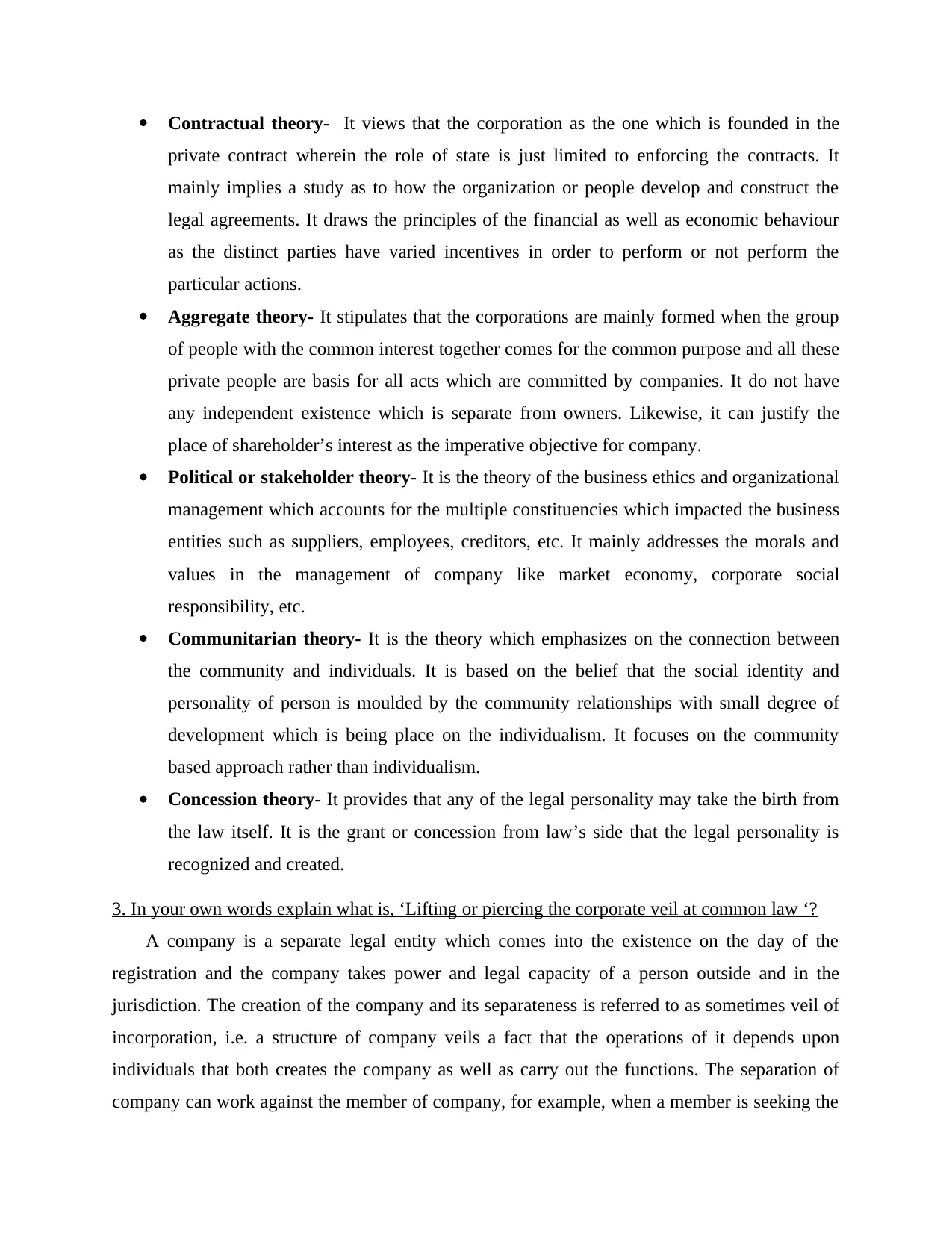
Contractual theory- It views that the corporation as the one which is founded in the
private contract wherein the role of state is just limited to enforcing the contracts. It
mainly implies a study as to how the organization or people develop and construct the
legal agreements. It draws the principles of the financial as well as economic behaviour
as the distinct parties have varied incentives in order to perform or not perform the
particular actions.
Aggregate theory- It stipulates that the corporations are mainly formed when the group
of people with the common interest together comes for the common purpose and all these
private people are basis for all acts which are committed by companies. It do not have
any independent existence which is separate from owners. Likewise, it can justify the
place of shareholder’s interest as the imperative objective for company.
Political or stakeholder theory- It is the theory of the business ethics and organizational
management which accounts for the multiple constituencies which impacted the business
entities such as suppliers, employees, creditors, etc. It mainly addresses the morals and
values in the management of company like market economy, corporate social
responsibility, etc.
Communitarian theory- It is the theory which emphasizes on the connection between
the community and individuals. It is based on the belief that the social identity and
personality of person is moulded by the community relationships with small degree of
development which is being place on the individualism. It focuses on the community
based approach rather than individualism.
Concession theory- It provides that any of the legal personality may take the birth from
the law itself. It is the grant or concession from law’s side that the legal personality is
recognized and created.
3. In your own words explain what is, ‘Lifting or piercing the corporate veil at common law ‘?
A company is a separate legal entity which comes into the existence on the day of the
registration and the company takes power and legal capacity of a person outside and in the
jurisdiction. The creation of the company and its separateness is referred to as sometimes veil of
incorporation, i.e. a structure of company veils a fact that the operations of it depends upon
individuals that both creates the company as well as carry out the functions. The separation of
company can work against the member of company, for example, when a member is seeking the
private contract wherein the role of state is just limited to enforcing the contracts. It
mainly implies a study as to how the organization or people develop and construct the
legal agreements. It draws the principles of the financial as well as economic behaviour
as the distinct parties have varied incentives in order to perform or not perform the
particular actions.
Aggregate theory- It stipulates that the corporations are mainly formed when the group
of people with the common interest together comes for the common purpose and all these
private people are basis for all acts which are committed by companies. It do not have
any independent existence which is separate from owners. Likewise, it can justify the
place of shareholder’s interest as the imperative objective for company.
Political or stakeholder theory- It is the theory of the business ethics and organizational
management which accounts for the multiple constituencies which impacted the business
entities such as suppliers, employees, creditors, etc. It mainly addresses the morals and
values in the management of company like market economy, corporate social
responsibility, etc.
Communitarian theory- It is the theory which emphasizes on the connection between
the community and individuals. It is based on the belief that the social identity and
personality of person is moulded by the community relationships with small degree of
development which is being place on the individualism. It focuses on the community
based approach rather than individualism.
Concession theory- It provides that any of the legal personality may take the birth from
the law itself. It is the grant or concession from law’s side that the legal personality is
recognized and created.
3. In your own words explain what is, ‘Lifting or piercing the corporate veil at common law ‘?
A company is a separate legal entity which comes into the existence on the day of the
registration and the company takes power and legal capacity of a person outside and in the
jurisdiction. The creation of the company and its separateness is referred to as sometimes veil of
incorporation, i.e. a structure of company veils a fact that the operations of it depends upon
individuals that both creates the company as well as carry out the functions. The separation of
company can work against the member of company, for example, when a member is seeking the
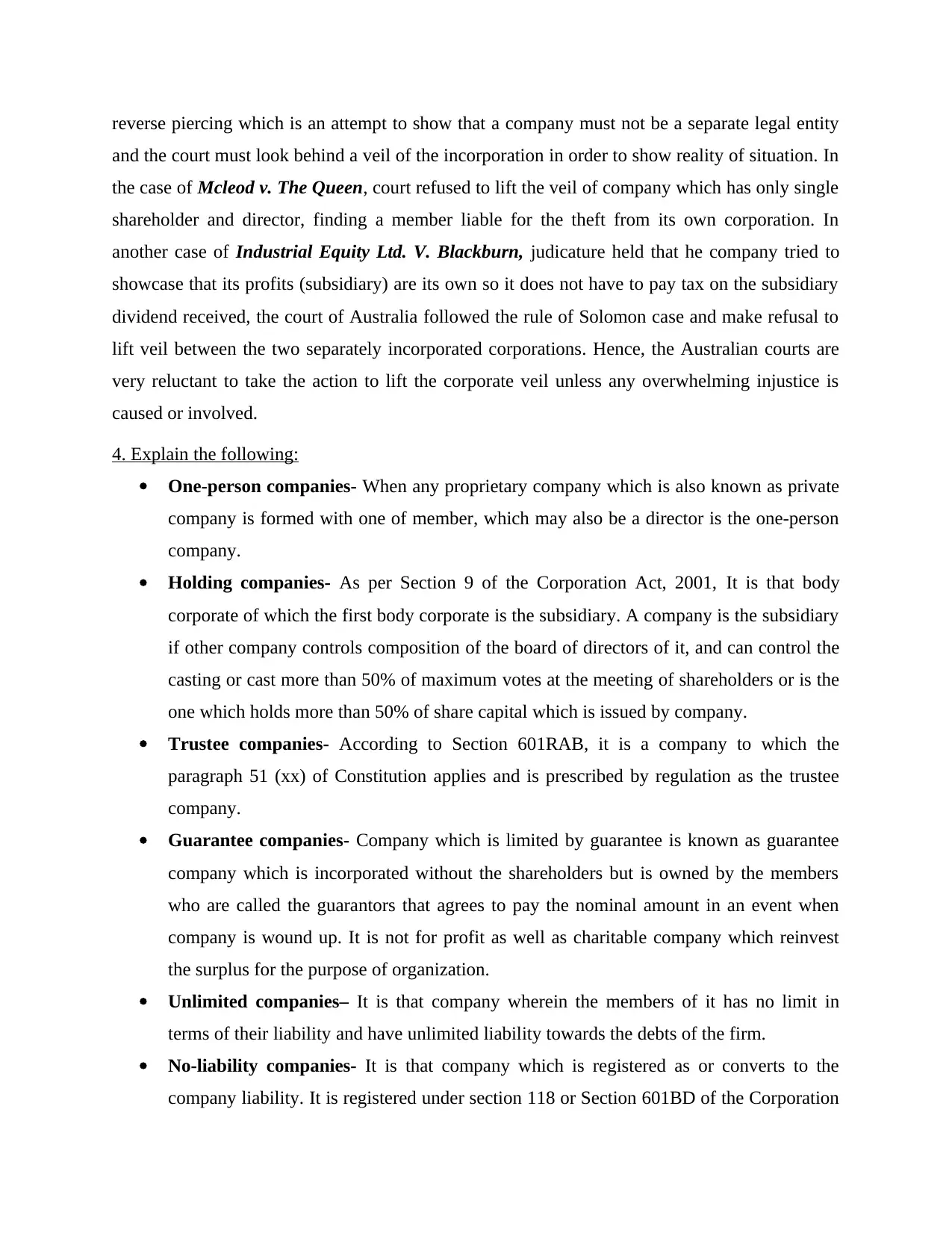
reverse piercing which is an attempt to show that a company must not be a separate legal entity
and the court must look behind a veil of the incorporation in order to show reality of situation. In
the case of Mcleod v. The Queen, court refused to lift the veil of company which has only single
shareholder and director, finding a member liable for the theft from its own corporation. In
another case of Industrial Equity Ltd. V. Blackburn, judicature held that he company tried to
showcase that its profits (subsidiary) are its own so it does not have to pay tax on the subsidiary
dividend received, the court of Australia followed the rule of Solomon case and make refusal to
lift veil between the two separately incorporated corporations. Hence, the Australian courts are
very reluctant to take the action to lift the corporate veil unless any overwhelming injustice is
caused or involved.
4. Explain the following:
One-person companies- When any proprietary company which is also known as private
company is formed with one of member, which may also be a director is the one-person
company.
Holding companies- As per Section 9 of the Corporation Act, 2001, It is that body
corporate of which the first body corporate is the subsidiary. A company is the subsidiary
if other company controls composition of the board of directors of it, and can control the
casting or cast more than 50% of maximum votes at the meeting of shareholders or is the
one which holds more than 50% of share capital which is issued by company.
Trustee companies- According to Section 601RAB, it is a company to which the
paragraph 51 (xx) of Constitution applies and is prescribed by regulation as the trustee
company.
Guarantee companies- Company which is limited by guarantee is known as guarantee
company which is incorporated without the shareholders but is owned by the members
who are called the guarantors that agrees to pay the nominal amount in an event when
company is wound up. It is not for profit as well as charitable company which reinvest
the surplus for the purpose of organization.
Unlimited companies– It is that company wherein the members of it has no limit in
terms of their liability and have unlimited liability towards the debts of the firm.
No-liability companies- It is that company which is registered as or converts to the
company liability. It is registered under section 118 or Section 601BD of the Corporation
and the court must look behind a veil of the incorporation in order to show reality of situation. In
the case of Mcleod v. The Queen, court refused to lift the veil of company which has only single
shareholder and director, finding a member liable for the theft from its own corporation. In
another case of Industrial Equity Ltd. V. Blackburn, judicature held that he company tried to
showcase that its profits (subsidiary) are its own so it does not have to pay tax on the subsidiary
dividend received, the court of Australia followed the rule of Solomon case and make refusal to
lift veil between the two separately incorporated corporations. Hence, the Australian courts are
very reluctant to take the action to lift the corporate veil unless any overwhelming injustice is
caused or involved.
4. Explain the following:
One-person companies- When any proprietary company which is also known as private
company is formed with one of member, which may also be a director is the one-person
company.
Holding companies- As per Section 9 of the Corporation Act, 2001, It is that body
corporate of which the first body corporate is the subsidiary. A company is the subsidiary
if other company controls composition of the board of directors of it, and can control the
casting or cast more than 50% of maximum votes at the meeting of shareholders or is the
one which holds more than 50% of share capital which is issued by company.
Trustee companies- According to Section 601RAB, it is a company to which the
paragraph 51 (xx) of Constitution applies and is prescribed by regulation as the trustee
company.
Guarantee companies- Company which is limited by guarantee is known as guarantee
company which is incorporated without the shareholders but is owned by the members
who are called the guarantors that agrees to pay the nominal amount in an event when
company is wound up. It is not for profit as well as charitable company which reinvest
the surplus for the purpose of organization.
Unlimited companies– It is that company wherein the members of it has no limit in
terms of their liability and have unlimited liability towards the debts of the firm.
No-liability companies- It is that company which is registered as or converts to the
company liability. It is registered under section 118 or Section 601BD of the Corporation
Secure Best Marks with AI Grader
Need help grading? Try our AI Grader for instant feedback on your assignments.
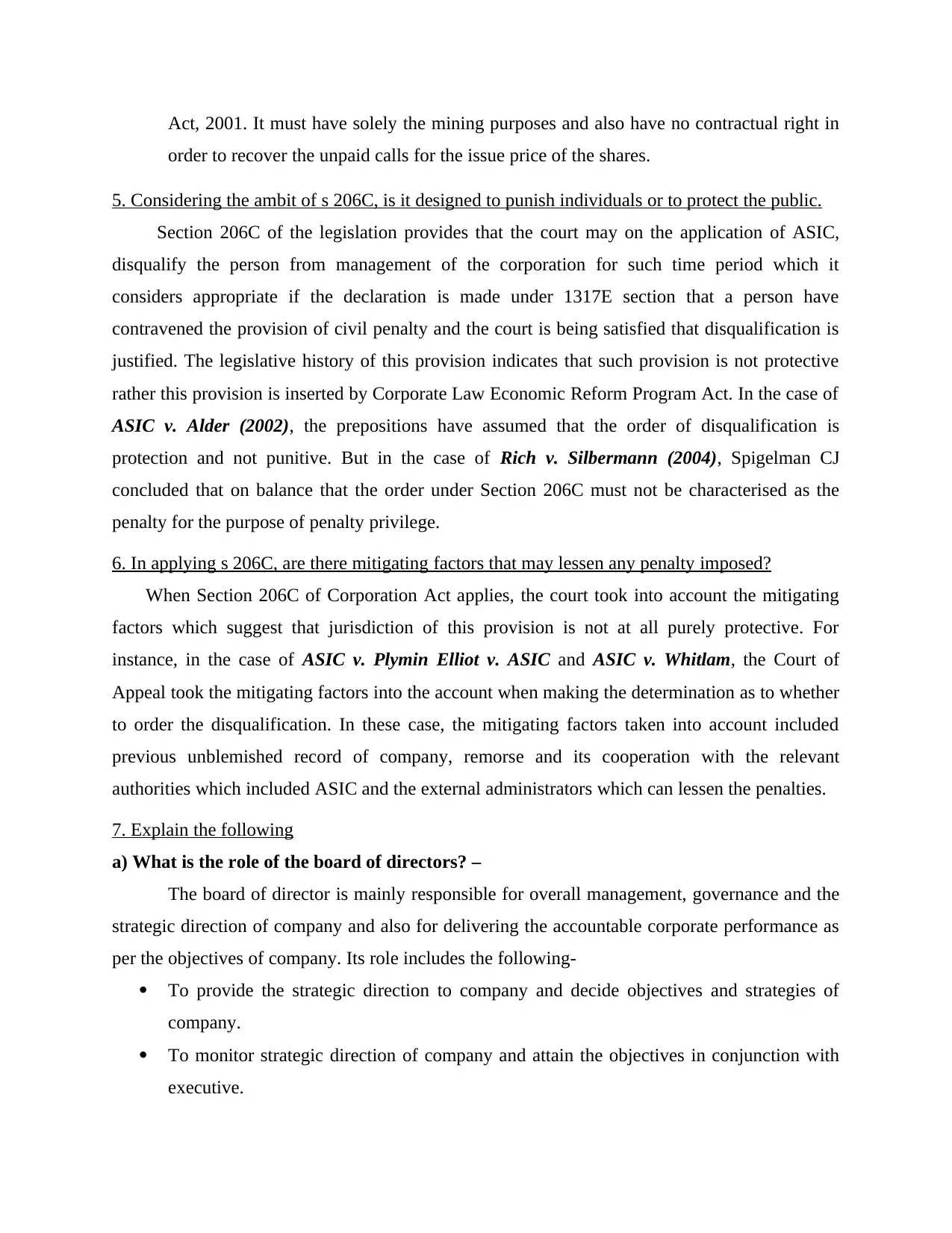
Act, 2001. It must have solely the mining purposes and also have no contractual right in
order to recover the unpaid calls for the issue price of the shares.
5. Considering the ambit of s 206C, is it designed to punish individuals or to protect the public.
Section 206C of the legislation provides that the court may on the application of ASIC,
disqualify the person from management of the corporation for such time period which it
considers appropriate if the declaration is made under 1317E section that a person have
contravened the provision of civil penalty and the court is being satisfied that disqualification is
justified. The legislative history of this provision indicates that such provision is not protective
rather this provision is inserted by Corporate Law Economic Reform Program Act. In the case of
ASIC v. Alder (2002), the prepositions have assumed that the order of disqualification is
protection and not punitive. But in the case of Rich v. Silbermann (2004), Spigelman CJ
concluded that on balance that the order under Section 206C must not be characterised as the
penalty for the purpose of penalty privilege.
6. In applying s 206C, are there mitigating factors that may lessen any penalty imposed?
When Section 206C of Corporation Act applies, the court took into account the mitigating
factors which suggest that jurisdiction of this provision is not at all purely protective. For
instance, in the case of ASIC v. Plymin Elliot v. ASIC and ASIC v. Whitlam, the Court of
Appeal took the mitigating factors into the account when making the determination as to whether
to order the disqualification. In these case, the mitigating factors taken into account included
previous unblemished record of company, remorse and its cooperation with the relevant
authorities which included ASIC and the external administrators which can lessen the penalties.
7. Explain the following
a) What is the role of the board of directors? –
The board of director is mainly responsible for overall management, governance and the
strategic direction of company and also for delivering the accountable corporate performance as
per the objectives of company. Its role includes the following-
To provide the strategic direction to company and decide objectives and strategies of
company.
To monitor strategic direction of company and attain the objectives in conjunction with
executive.
order to recover the unpaid calls for the issue price of the shares.
5. Considering the ambit of s 206C, is it designed to punish individuals or to protect the public.
Section 206C of the legislation provides that the court may on the application of ASIC,
disqualify the person from management of the corporation for such time period which it
considers appropriate if the declaration is made under 1317E section that a person have
contravened the provision of civil penalty and the court is being satisfied that disqualification is
justified. The legislative history of this provision indicates that such provision is not protective
rather this provision is inserted by Corporate Law Economic Reform Program Act. In the case of
ASIC v. Alder (2002), the prepositions have assumed that the order of disqualification is
protection and not punitive. But in the case of Rich v. Silbermann (2004), Spigelman CJ
concluded that on balance that the order under Section 206C must not be characterised as the
penalty for the purpose of penalty privilege.
6. In applying s 206C, are there mitigating factors that may lessen any penalty imposed?
When Section 206C of Corporation Act applies, the court took into account the mitigating
factors which suggest that jurisdiction of this provision is not at all purely protective. For
instance, in the case of ASIC v. Plymin Elliot v. ASIC and ASIC v. Whitlam, the Court of
Appeal took the mitigating factors into the account when making the determination as to whether
to order the disqualification. In these case, the mitigating factors taken into account included
previous unblemished record of company, remorse and its cooperation with the relevant
authorities which included ASIC and the external administrators which can lessen the penalties.
7. Explain the following
a) What is the role of the board of directors? –
The board of director is mainly responsible for overall management, governance and the
strategic direction of company and also for delivering the accountable corporate performance as
per the objectives of company. Its role includes the following-
To provide the strategic direction to company and decide objectives and strategies of
company.
To monitor strategic direction of company and attain the objectives in conjunction with
executive.
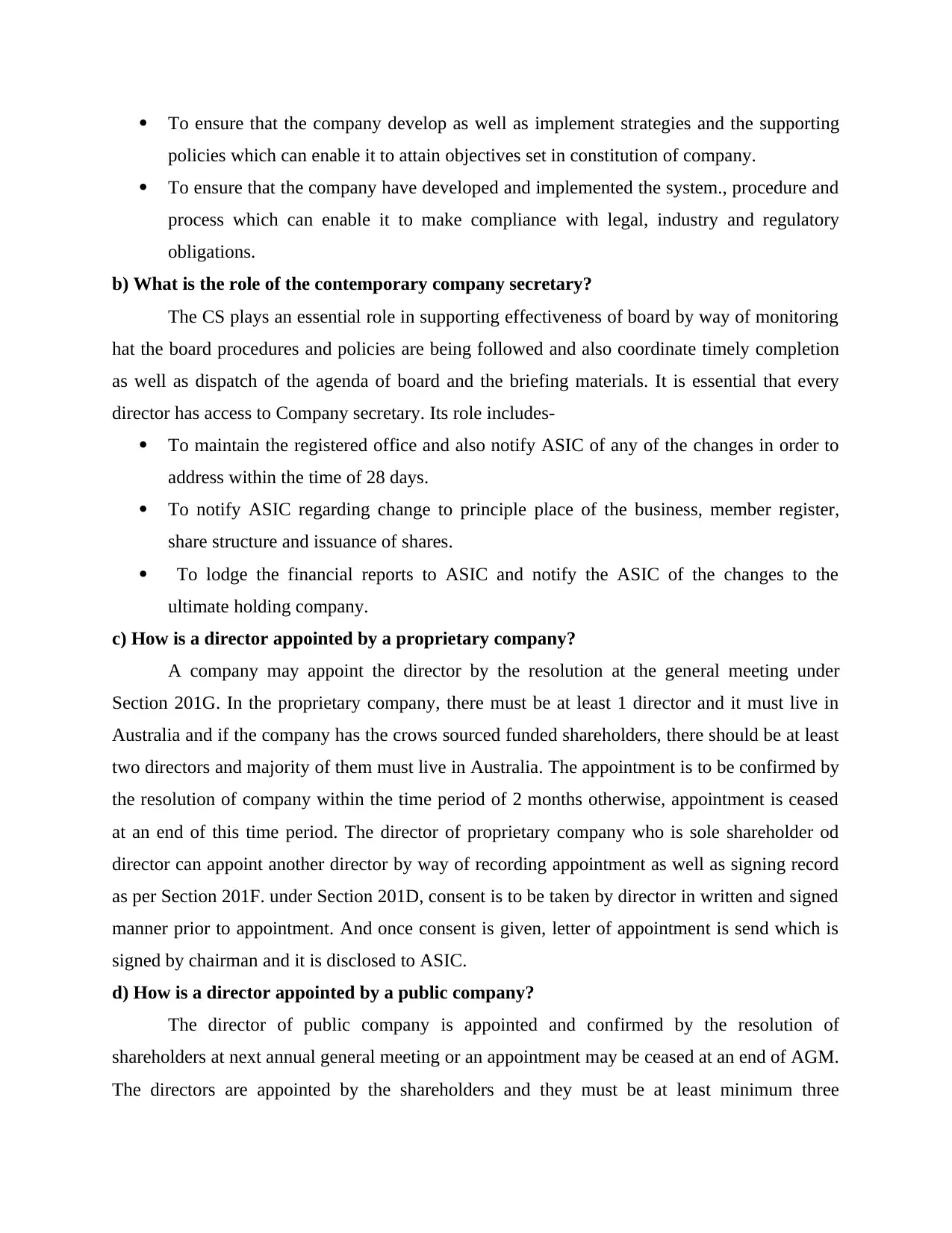
To ensure that the company develop as well as implement strategies and the supporting
policies which can enable it to attain objectives set in constitution of company.
To ensure that the company have developed and implemented the system., procedure and
process which can enable it to make compliance with legal, industry and regulatory
obligations.
b) What is the role of the contemporary company secretary?
The CS plays an essential role in supporting effectiveness of board by way of monitoring
hat the board procedures and policies are being followed and also coordinate timely completion
as well as dispatch of the agenda of board and the briefing materials. It is essential that every
director has access to Company secretary. Its role includes-
To maintain the registered office and also notify ASIC of any of the changes in order to
address within the time of 28 days.
To notify ASIC regarding change to principle place of the business, member register,
share structure and issuance of shares.
To lodge the financial reports to ASIC and notify the ASIC of the changes to the
ultimate holding company.
c) How is a director appointed by a proprietary company?
A company may appoint the director by the resolution at the general meeting under
Section 201G. In the proprietary company, there must be at least 1 director and it must live in
Australia and if the company has the crows sourced funded shareholders, there should be at least
two directors and majority of them must live in Australia. The appointment is to be confirmed by
the resolution of company within the time period of 2 months otherwise, appointment is ceased
at an end of this time period. The director of proprietary company who is sole shareholder od
director can appoint another director by way of recording appointment as well as signing record
as per Section 201F. under Section 201D, consent is to be taken by director in written and signed
manner prior to appointment. And once consent is given, letter of appointment is send which is
signed by chairman and it is disclosed to ASIC.
d) How is a director appointed by a public company?
The director of public company is appointed and confirmed by the resolution of
shareholders at next annual general meeting or an appointment may be ceased at an end of AGM.
The directors are appointed by the shareholders and they must be at least minimum three
policies which can enable it to attain objectives set in constitution of company.
To ensure that the company have developed and implemented the system., procedure and
process which can enable it to make compliance with legal, industry and regulatory
obligations.
b) What is the role of the contemporary company secretary?
The CS plays an essential role in supporting effectiveness of board by way of monitoring
hat the board procedures and policies are being followed and also coordinate timely completion
as well as dispatch of the agenda of board and the briefing materials. It is essential that every
director has access to Company secretary. Its role includes-
To maintain the registered office and also notify ASIC of any of the changes in order to
address within the time of 28 days.
To notify ASIC regarding change to principle place of the business, member register,
share structure and issuance of shares.
To lodge the financial reports to ASIC and notify the ASIC of the changes to the
ultimate holding company.
c) How is a director appointed by a proprietary company?
A company may appoint the director by the resolution at the general meeting under
Section 201G. In the proprietary company, there must be at least 1 director and it must live in
Australia and if the company has the crows sourced funded shareholders, there should be at least
two directors and majority of them must live in Australia. The appointment is to be confirmed by
the resolution of company within the time period of 2 months otherwise, appointment is ceased
at an end of this time period. The director of proprietary company who is sole shareholder od
director can appoint another director by way of recording appointment as well as signing record
as per Section 201F. under Section 201D, consent is to be taken by director in written and signed
manner prior to appointment. And once consent is given, letter of appointment is send which is
signed by chairman and it is disclosed to ASIC.
d) How is a director appointed by a public company?
The director of public company is appointed and confirmed by the resolution of
shareholders at next annual general meeting or an appointment may be ceased at an end of AGM.
The directors are appointed by the shareholders and they must be at least minimum three
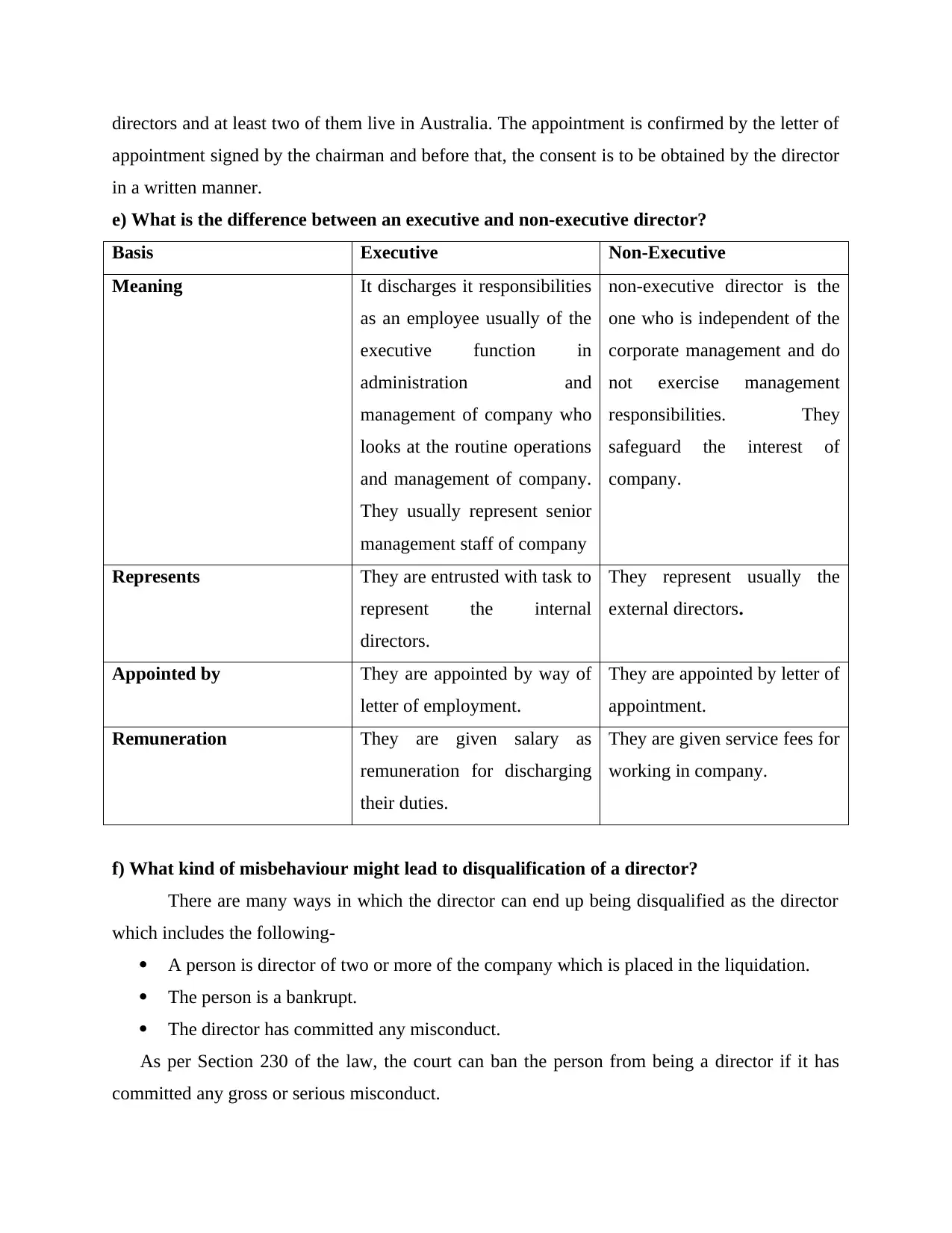
directors and at least two of them live in Australia. The appointment is confirmed by the letter of
appointment signed by the chairman and before that, the consent is to be obtained by the director
in a written manner.
e) What is the difference between an executive and non-executive director?
Basis Executive Non-Executive
Meaning It discharges it responsibilities
as an employee usually of the
executive function in
administration and
management of company who
looks at the routine operations
and management of company.
They usually represent senior
management staff of company
non-executive director is the
one who is independent of the
corporate management and do
not exercise management
responsibilities. They
safeguard the interest of
company.
Represents They are entrusted with task to
represent the internal
directors.
They represent usually the
external directors.
Appointed by They are appointed by way of
letter of employment.
They are appointed by letter of
appointment.
Remuneration They are given salary as
remuneration for discharging
their duties.
They are given service fees for
working in company.
f) What kind of misbehaviour might lead to disqualification of a director?
There are many ways in which the director can end up being disqualified as the director
which includes the following-
A person is director of two or more of the company which is placed in the liquidation.
The person is a bankrupt.
The director has committed any misconduct.
As per Section 230 of the law, the court can ban the person from being a director if it has
committed any gross or serious misconduct.
appointment signed by the chairman and before that, the consent is to be obtained by the director
in a written manner.
e) What is the difference between an executive and non-executive director?
Basis Executive Non-Executive
Meaning It discharges it responsibilities
as an employee usually of the
executive function in
administration and
management of company who
looks at the routine operations
and management of company.
They usually represent senior
management staff of company
non-executive director is the
one who is independent of the
corporate management and do
not exercise management
responsibilities. They
safeguard the interest of
company.
Represents They are entrusted with task to
represent the internal
directors.
They represent usually the
external directors.
Appointed by They are appointed by way of
letter of employment.
They are appointed by letter of
appointment.
Remuneration They are given salary as
remuneration for discharging
their duties.
They are given service fees for
working in company.
f) What kind of misbehaviour might lead to disqualification of a director?
There are many ways in which the director can end up being disqualified as the director
which includes the following-
A person is director of two or more of the company which is placed in the liquidation.
The person is a bankrupt.
The director has committed any misconduct.
As per Section 230 of the law, the court can ban the person from being a director if it has
committed any gross or serious misconduct.
Paraphrase This Document
Need a fresh take? Get an instant paraphrase of this document with our AI Paraphraser
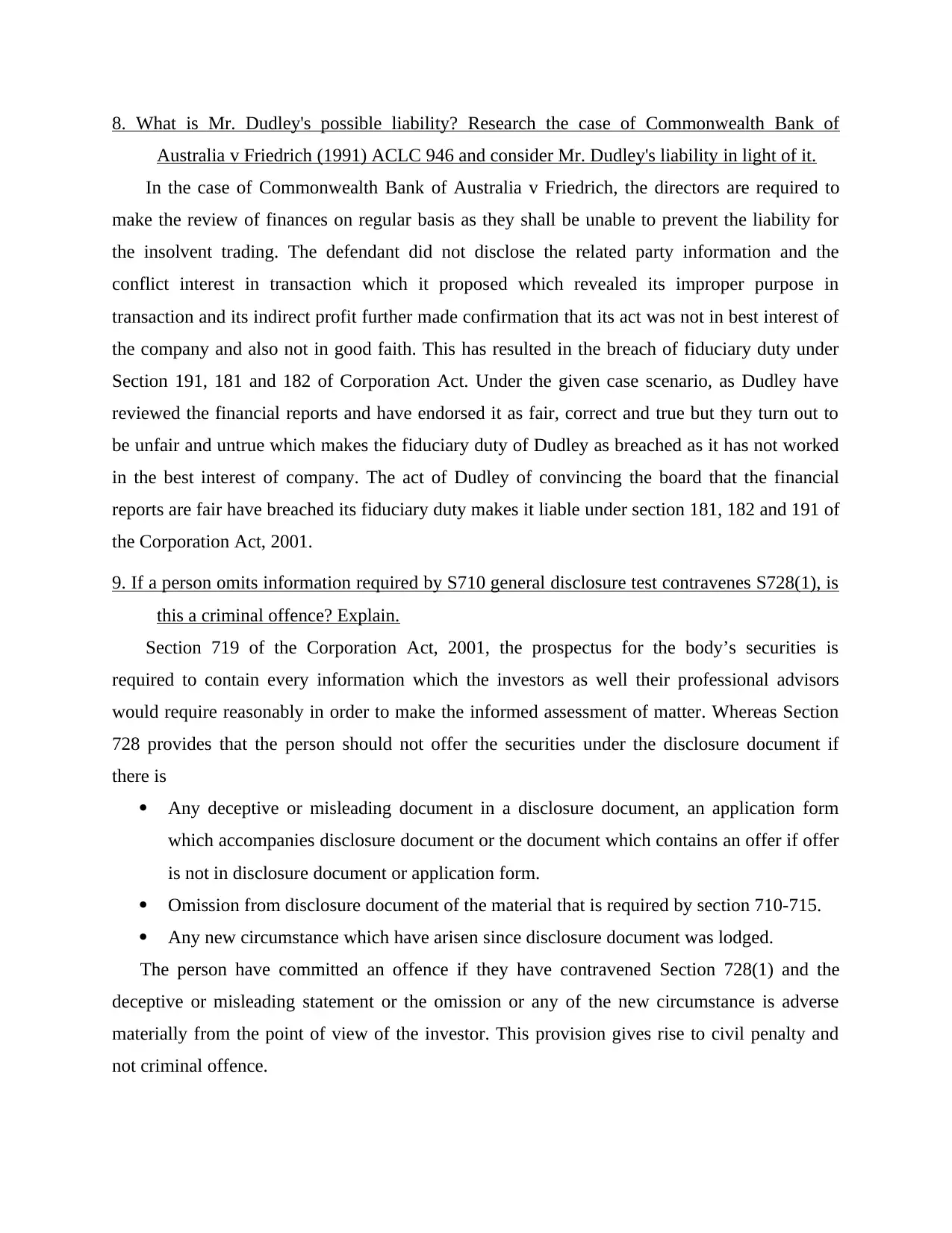
8. What is Mr. Dudley's possible liability? Research the case of Commonwealth Bank of
Australia v Friedrich (1991) ACLC 946 and consider Mr. Dudley's liability in light of it.
In the case of Commonwealth Bank of Australia v Friedrich, the directors are required to
make the review of finances on regular basis as they shall be unable to prevent the liability for
the insolvent trading. The defendant did not disclose the related party information and the
conflict interest in transaction which it proposed which revealed its improper purpose in
transaction and its indirect profit further made confirmation that its act was not in best interest of
the company and also not in good faith. This has resulted in the breach of fiduciary duty under
Section 191, 181 and 182 of Corporation Act. Under the given case scenario, as Dudley have
reviewed the financial reports and have endorsed it as fair, correct and true but they turn out to
be unfair and untrue which makes the fiduciary duty of Dudley as breached as it has not worked
in the best interest of company. The act of Dudley of convincing the board that the financial
reports are fair have breached its fiduciary duty makes it liable under section 181, 182 and 191 of
the Corporation Act, 2001.
9. If a person omits information required by S710 general disclosure test contravenes S728(1), is
this a criminal offence? Explain.
Section 719 of the Corporation Act, 2001, the prospectus for the body’s securities is
required to contain every information which the investors as well their professional advisors
would require reasonably in order to make the informed assessment of matter. Whereas Section
728 provides that the person should not offer the securities under the disclosure document if
there is
Any deceptive or misleading document in a disclosure document, an application form
which accompanies disclosure document or the document which contains an offer if offer
is not in disclosure document or application form.
Omission from disclosure document of the material that is required by section 710-715.
Any new circumstance which have arisen since disclosure document was lodged.
The person have committed an offence if they have contravened Section 728(1) and the
deceptive or misleading statement or the omission or any of the new circumstance is adverse
materially from the point of view of the investor. This provision gives rise to civil penalty and
not criminal offence.
Australia v Friedrich (1991) ACLC 946 and consider Mr. Dudley's liability in light of it.
In the case of Commonwealth Bank of Australia v Friedrich, the directors are required to
make the review of finances on regular basis as they shall be unable to prevent the liability for
the insolvent trading. The defendant did not disclose the related party information and the
conflict interest in transaction which it proposed which revealed its improper purpose in
transaction and its indirect profit further made confirmation that its act was not in best interest of
the company and also not in good faith. This has resulted in the breach of fiduciary duty under
Section 191, 181 and 182 of Corporation Act. Under the given case scenario, as Dudley have
reviewed the financial reports and have endorsed it as fair, correct and true but they turn out to
be unfair and untrue which makes the fiduciary duty of Dudley as breached as it has not worked
in the best interest of company. The act of Dudley of convincing the board that the financial
reports are fair have breached its fiduciary duty makes it liable under section 181, 182 and 191 of
the Corporation Act, 2001.
9. If a person omits information required by S710 general disclosure test contravenes S728(1), is
this a criminal offence? Explain.
Section 719 of the Corporation Act, 2001, the prospectus for the body’s securities is
required to contain every information which the investors as well their professional advisors
would require reasonably in order to make the informed assessment of matter. Whereas Section
728 provides that the person should not offer the securities under the disclosure document if
there is
Any deceptive or misleading document in a disclosure document, an application form
which accompanies disclosure document or the document which contains an offer if offer
is not in disclosure document or application form.
Omission from disclosure document of the material that is required by section 710-715.
Any new circumstance which have arisen since disclosure document was lodged.
The person have committed an offence if they have contravened Section 728(1) and the
deceptive or misleading statement or the omission or any of the new circumstance is adverse
materially from the point of view of the investor. This provision gives rise to civil penalty and
not criminal offence.
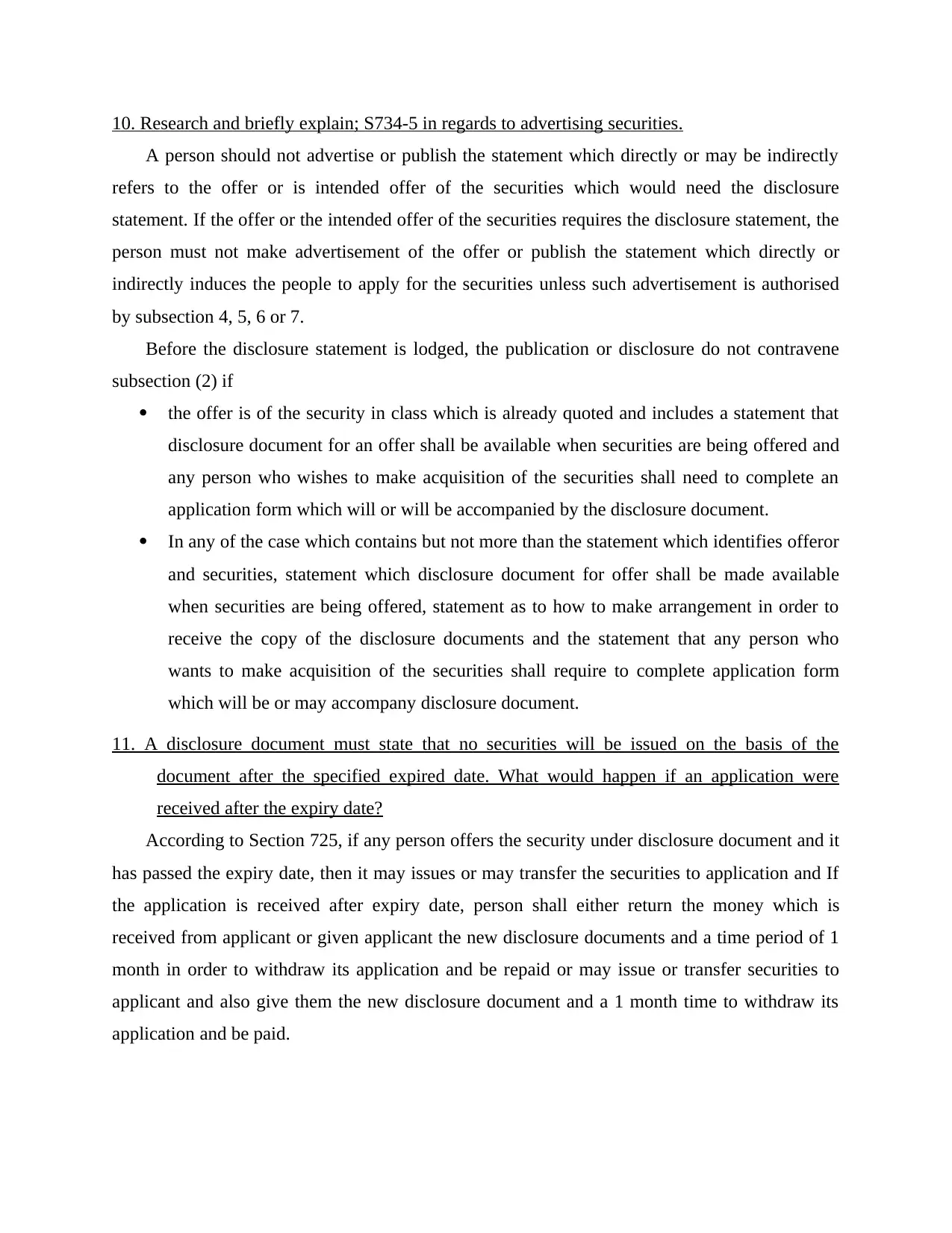
10. Research and briefly explain; S734-5 in regards to advertising securities.
A person should not advertise or publish the statement which directly or may be indirectly
refers to the offer or is intended offer of the securities which would need the disclosure
statement. If the offer or the intended offer of the securities requires the disclosure statement, the
person must not make advertisement of the offer or publish the statement which directly or
indirectly induces the people to apply for the securities unless such advertisement is authorised
by subsection 4, 5, 6 or 7.
Before the disclosure statement is lodged, the publication or disclosure do not contravene
subsection (2) if
the offer is of the security in class which is already quoted and includes a statement that
disclosure document for an offer shall be available when securities are being offered and
any person who wishes to make acquisition of the securities shall need to complete an
application form which will or will be accompanied by the disclosure document.
In any of the case which contains but not more than the statement which identifies offeror
and securities, statement which disclosure document for offer shall be made available
when securities are being offered, statement as to how to make arrangement in order to
receive the copy of the disclosure documents and the statement that any person who
wants to make acquisition of the securities shall require to complete application form
which will be or may accompany disclosure document.
11. A disclosure document must state that no securities will be issued on the basis of the
document after the specified expired date. What would happen if an application were
received after the expiry date?
According to Section 725, if any person offers the security under disclosure document and it
has passed the expiry date, then it may issues or may transfer the securities to application and If
the application is received after expiry date, person shall either return the money which is
received from applicant or given applicant the new disclosure documents and a time period of 1
month in order to withdraw its application and be repaid or may issue or transfer securities to
applicant and also give them the new disclosure document and a 1 month time to withdraw its
application and be paid.
A person should not advertise or publish the statement which directly or may be indirectly
refers to the offer or is intended offer of the securities which would need the disclosure
statement. If the offer or the intended offer of the securities requires the disclosure statement, the
person must not make advertisement of the offer or publish the statement which directly or
indirectly induces the people to apply for the securities unless such advertisement is authorised
by subsection 4, 5, 6 or 7.
Before the disclosure statement is lodged, the publication or disclosure do not contravene
subsection (2) if
the offer is of the security in class which is already quoted and includes a statement that
disclosure document for an offer shall be available when securities are being offered and
any person who wishes to make acquisition of the securities shall need to complete an
application form which will or will be accompanied by the disclosure document.
In any of the case which contains but not more than the statement which identifies offeror
and securities, statement which disclosure document for offer shall be made available
when securities are being offered, statement as to how to make arrangement in order to
receive the copy of the disclosure documents and the statement that any person who
wants to make acquisition of the securities shall require to complete application form
which will be or may accompany disclosure document.
11. A disclosure document must state that no securities will be issued on the basis of the
document after the specified expired date. What would happen if an application were
received after the expiry date?
According to Section 725, if any person offers the security under disclosure document and it
has passed the expiry date, then it may issues or may transfer the securities to application and If
the application is received after expiry date, person shall either return the money which is
received from applicant or given applicant the new disclosure documents and a time period of 1
month in order to withdraw its application and be repaid or may issue or transfer securities to
applicant and also give them the new disclosure document and a 1 month time to withdraw its
application and be paid.
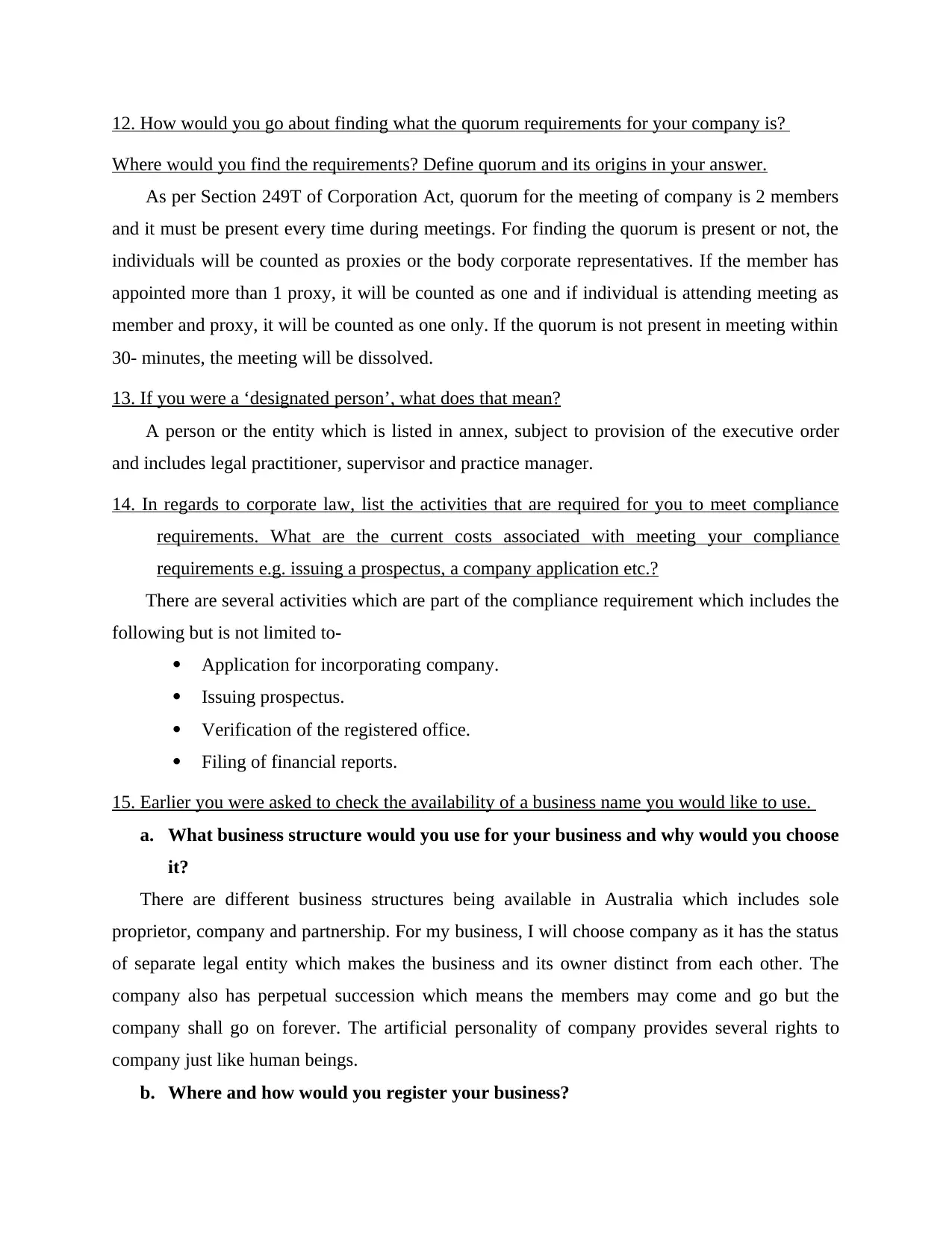
12. How would you go about finding what the quorum requirements for your company is?
Where would you find the requirements? Define quorum and its origins in your answer.
As per Section 249T of Corporation Act, quorum for the meeting of company is 2 members
and it must be present every time during meetings. For finding the quorum is present or not, the
individuals will be counted as proxies or the body corporate representatives. If the member has
appointed more than 1 proxy, it will be counted as one and if individual is attending meeting as
member and proxy, it will be counted as one only. If the quorum is not present in meeting within
30- minutes, the meeting will be dissolved.
13. If you were a ‘designated person’, what does that mean?
A person or the entity which is listed in annex, subject to provision of the executive order
and includes legal practitioner, supervisor and practice manager.
14. In regards to corporate law, list the activities that are required for you to meet compliance
requirements. What are the current costs associated with meeting your compliance
requirements e.g. issuing a prospectus, a company application etc.?
There are several activities which are part of the compliance requirement which includes the
following but is not limited to-
Application for incorporating company.
Issuing prospectus.
Verification of the registered office.
Filing of financial reports.
15. Earlier you were asked to check the availability of a business name you would like to use.
a. What business structure would you use for your business and why would you choose
it?
There are different business structures being available in Australia which includes sole
proprietor, company and partnership. For my business, I will choose company as it has the status
of separate legal entity which makes the business and its owner distinct from each other. The
company also has perpetual succession which means the members may come and go but the
company shall go on forever. The artificial personality of company provides several rights to
company just like human beings.
b. Where and how would you register your business?
Where would you find the requirements? Define quorum and its origins in your answer.
As per Section 249T of Corporation Act, quorum for the meeting of company is 2 members
and it must be present every time during meetings. For finding the quorum is present or not, the
individuals will be counted as proxies or the body corporate representatives. If the member has
appointed more than 1 proxy, it will be counted as one and if individual is attending meeting as
member and proxy, it will be counted as one only. If the quorum is not present in meeting within
30- minutes, the meeting will be dissolved.
13. If you were a ‘designated person’, what does that mean?
A person or the entity which is listed in annex, subject to provision of the executive order
and includes legal practitioner, supervisor and practice manager.
14. In regards to corporate law, list the activities that are required for you to meet compliance
requirements. What are the current costs associated with meeting your compliance
requirements e.g. issuing a prospectus, a company application etc.?
There are several activities which are part of the compliance requirement which includes the
following but is not limited to-
Application for incorporating company.
Issuing prospectus.
Verification of the registered office.
Filing of financial reports.
15. Earlier you were asked to check the availability of a business name you would like to use.
a. What business structure would you use for your business and why would you choose
it?
There are different business structures being available in Australia which includes sole
proprietor, company and partnership. For my business, I will choose company as it has the status
of separate legal entity which makes the business and its owner distinct from each other. The
company also has perpetual succession which means the members may come and go but the
company shall go on forever. The artificial personality of company provides several rights to
company just like human beings.
b. Where and how would you register your business?
Secure Best Marks with AI Grader
Need help grading? Try our AI Grader for instant feedback on your assignments.
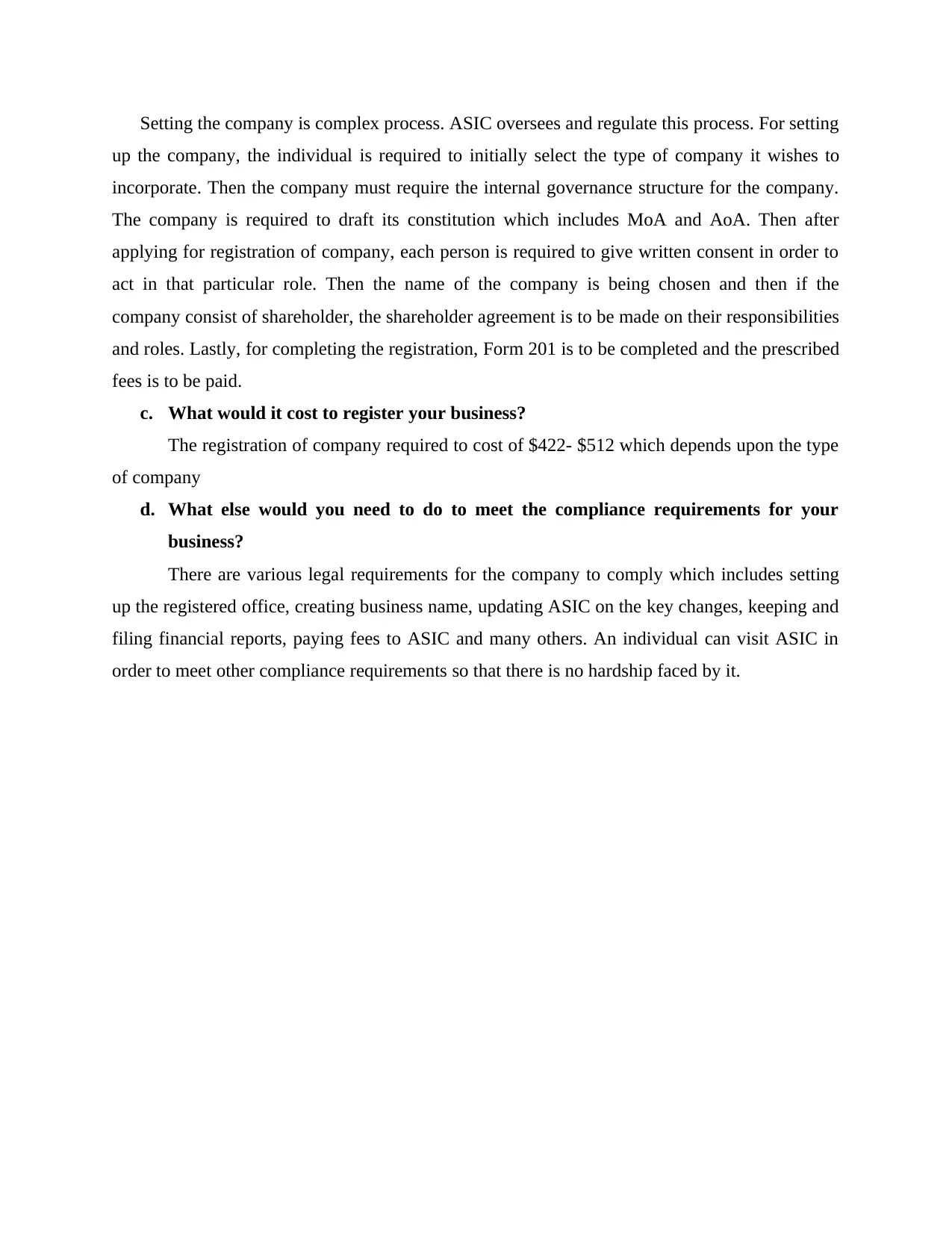
Setting the company is complex process. ASIC oversees and regulate this process. For setting
up the company, the individual is required to initially select the type of company it wishes to
incorporate. Then the company must require the internal governance structure for the company.
The company is required to draft its constitution which includes MoA and AoA. Then after
applying for registration of company, each person is required to give written consent in order to
act in that particular role. Then the name of the company is being chosen and then if the
company consist of shareholder, the shareholder agreement is to be made on their responsibilities
and roles. Lastly, for completing the registration, Form 201 is to be completed and the prescribed
fees is to be paid.
c. What would it cost to register your business?
The registration of company required to cost of $422- $512 which depends upon the type
of company
d. What else would you need to do to meet the compliance requirements for your
business?
There are various legal requirements for the company to comply which includes setting
up the registered office, creating business name, updating ASIC on the key changes, keeping and
filing financial reports, paying fees to ASIC and many others. An individual can visit ASIC in
order to meet other compliance requirements so that there is no hardship faced by it.
up the company, the individual is required to initially select the type of company it wishes to
incorporate. Then the company must require the internal governance structure for the company.
The company is required to draft its constitution which includes MoA and AoA. Then after
applying for registration of company, each person is required to give written consent in order to
act in that particular role. Then the name of the company is being chosen and then if the
company consist of shareholder, the shareholder agreement is to be made on their responsibilities
and roles. Lastly, for completing the registration, Form 201 is to be completed and the prescribed
fees is to be paid.
c. What would it cost to register your business?
The registration of company required to cost of $422- $512 which depends upon the type
of company
d. What else would you need to do to meet the compliance requirements for your
business?
There are various legal requirements for the company to comply which includes setting
up the registered office, creating business name, updating ASIC on the key changes, keeping and
filing financial reports, paying fees to ASIC and many others. An individual can visit ASIC in
order to meet other compliance requirements so that there is no hardship faced by it.
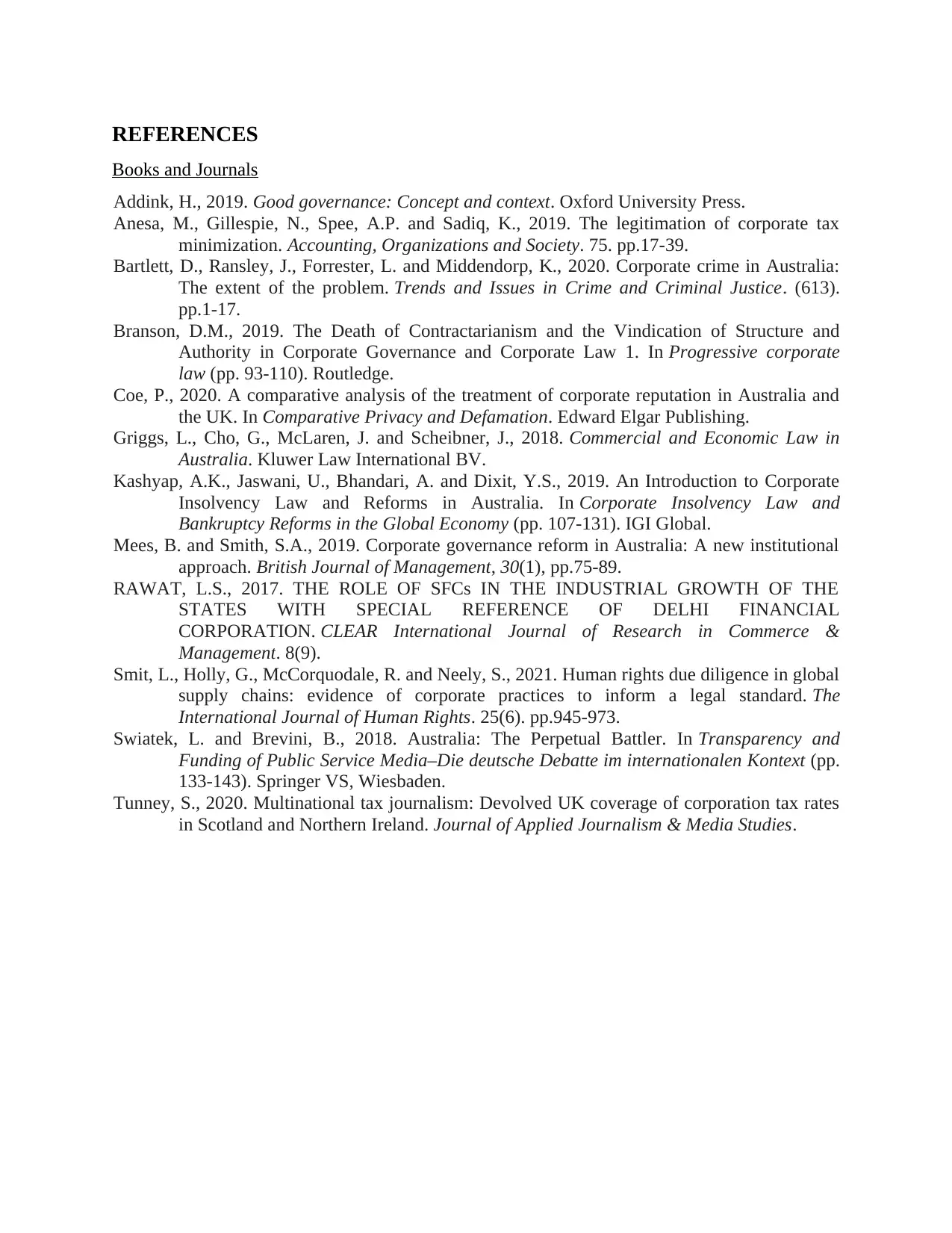
REFERENCES
Books and Journals
Addink, H., 2019. Good governance: Concept and context. Oxford University Press.
Anesa, M., Gillespie, N., Spee, A.P. and Sadiq, K., 2019. The legitimation of corporate tax
minimization. Accounting, Organizations and Society. 75. pp.17-39.
Bartlett, D., Ransley, J., Forrester, L. and Middendorp, K., 2020. Corporate crime in Australia:
The extent of the problem. Trends and Issues in Crime and Criminal Justice. (613).
pp.1-17.
Branson, D.M., 2019. The Death of Contractarianism and the Vindication of Structure and
Authority in Corporate Governance and Corporate Law 1. In Progressive corporate
law (pp. 93-110). Routledge.
Coe, P., 2020. A comparative analysis of the treatment of corporate reputation in Australia and
the UK. In Comparative Privacy and Defamation. Edward Elgar Publishing.
Griggs, L., Cho, G., McLaren, J. and Scheibner, J., 2018. Commercial and Economic Law in
Australia. Kluwer Law International BV.
Kashyap, A.K., Jaswani, U., Bhandari, A. and Dixit, Y.S., 2019. An Introduction to Corporate
Insolvency Law and Reforms in Australia. In Corporate Insolvency Law and
Bankruptcy Reforms in the Global Economy (pp. 107-131). IGI Global.
Mees, B. and Smith, S.A., 2019. Corporate governance reform in Australia: A new institutional
approach. British Journal of Management, 30(1), pp.75-89.
RAWAT, L.S., 2017. THE ROLE OF SFCs IN THE INDUSTRIAL GROWTH OF THE
STATES WITH SPECIAL REFERENCE OF DELHI FINANCIAL
CORPORATION. CLEAR International Journal of Research in Commerce &
Management. 8(9).
Smit, L., Holly, G., McCorquodale, R. and Neely, S., 2021. Human rights due diligence in global
supply chains: evidence of corporate practices to inform a legal standard. The
International Journal of Human Rights. 25(6). pp.945-973.
Swiatek, L. and Brevini, B., 2018. Australia: The Perpetual Battler. In Transparency and
Funding of Public Service Media–Die deutsche Debatte im internationalen Kontext (pp.
133-143). Springer VS, Wiesbaden.
Tunney, S., 2020. Multinational tax journalism: Devolved UK coverage of corporation tax rates
in Scotland and Northern Ireland. Journal of Applied Journalism & Media Studies.
Books and Journals
Addink, H., 2019. Good governance: Concept and context. Oxford University Press.
Anesa, M., Gillespie, N., Spee, A.P. and Sadiq, K., 2019. The legitimation of corporate tax
minimization. Accounting, Organizations and Society. 75. pp.17-39.
Bartlett, D., Ransley, J., Forrester, L. and Middendorp, K., 2020. Corporate crime in Australia:
The extent of the problem. Trends and Issues in Crime and Criminal Justice. (613).
pp.1-17.
Branson, D.M., 2019. The Death of Contractarianism and the Vindication of Structure and
Authority in Corporate Governance and Corporate Law 1. In Progressive corporate
law (pp. 93-110). Routledge.
Coe, P., 2020. A comparative analysis of the treatment of corporate reputation in Australia and
the UK. In Comparative Privacy and Defamation. Edward Elgar Publishing.
Griggs, L., Cho, G., McLaren, J. and Scheibner, J., 2018. Commercial and Economic Law in
Australia. Kluwer Law International BV.
Kashyap, A.K., Jaswani, U., Bhandari, A. and Dixit, Y.S., 2019. An Introduction to Corporate
Insolvency Law and Reforms in Australia. In Corporate Insolvency Law and
Bankruptcy Reforms in the Global Economy (pp. 107-131). IGI Global.
Mees, B. and Smith, S.A., 2019. Corporate governance reform in Australia: A new institutional
approach. British Journal of Management, 30(1), pp.75-89.
RAWAT, L.S., 2017. THE ROLE OF SFCs IN THE INDUSTRIAL GROWTH OF THE
STATES WITH SPECIAL REFERENCE OF DELHI FINANCIAL
CORPORATION. CLEAR International Journal of Research in Commerce &
Management. 8(9).
Smit, L., Holly, G., McCorquodale, R. and Neely, S., 2021. Human rights due diligence in global
supply chains: evidence of corporate practices to inform a legal standard. The
International Journal of Human Rights. 25(6). pp.945-973.
Swiatek, L. and Brevini, B., 2018. Australia: The Perpetual Battler. In Transparency and
Funding of Public Service Media–Die deutsche Debatte im internationalen Kontext (pp.
133-143). Springer VS, Wiesbaden.
Tunney, S., 2020. Multinational tax journalism: Devolved UK coverage of corporation tax rates
in Scotland and Northern Ireland. Journal of Applied Journalism & Media Studies.
1 out of 18
Related Documents
Your All-in-One AI-Powered Toolkit for Academic Success.
+13062052269
info@desklib.com
Available 24*7 on WhatsApp / Email
![[object Object]](/_next/static/media/star-bottom.7253800d.svg)
Unlock your academic potential
© 2024 | Zucol Services PVT LTD | All rights reserved.





